
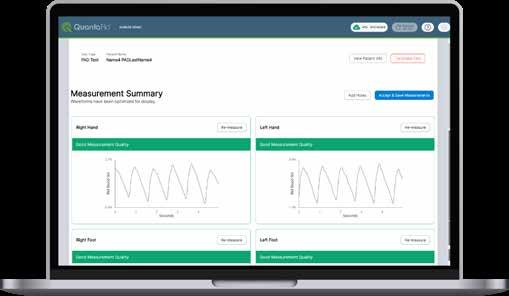
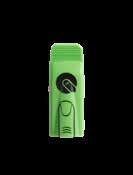

Physicians office Resource 2023 | Issue 8 Resources for You, Your Patients, & Your Practice THE POWER TO DETECT THE HIDDEN THREAT OF PAD THE POWER OF NEXT GENERATION POINT OF CARE DIAGNOSTICS MDescapes — ISLAND OASIS: THE OCEAN CLUB, A FOUR SEASONS RESORT 6 32
Comprehensive toxicology menu now with 14 CLIA 1 categorized moderate complexity assays.

BENCHTOP ANALYZER
Toxicology screening solutions for physician offices, pain management, treatment centers and laboratories testing 200+ patient samples/mo.
MODERATE COMPLEXITY ASSAYS – FDA 510(K) CLEARED
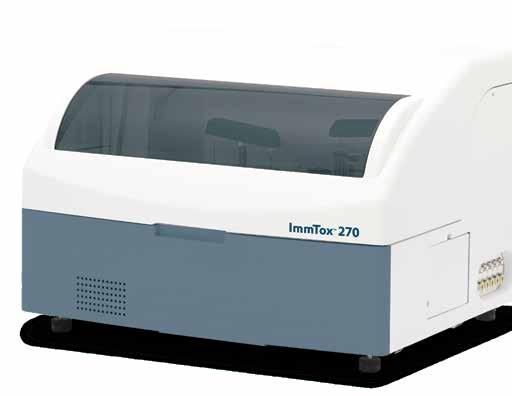
6-acetylmorphine (6-AM Heroin metabolite)
Amphetamine
Barbiturates
Benzodiazepines
Benzoylecgonine (Cocaine metabolite)
Buprenorphine
Cannabinoids (THC)
270
EDDP (Methadone metabolite)

Fentanyl*
Methamphetamine
Opiates
Oxycodone
Phencyclidine (PCP)
Tramadol
TOXICOLOGY SCREENING SIMPLIFIED.
IMMTOX ™ 270
© 2022 Abbott. All rights reserved. All trademarks referenced are trademarks of either the Abbott group of companies or their respective owners. Any photos displayed are for illustrative purposes only. COL-09575 v3 12/22 1. Clinical Laboratory Improvement Amendments (CLIA) / * SEFRIA Fentanyl
Scan this QR code to view the ImmTox™
product video
CONTACT ABBOTT CLINICAL LAB SOLUTIONS
CLS_SALES@ABBOTT.COM 3000
855-425-9428 |
Getting the most from this guide
There are two simple ways to request information about the products and services found in Physicians Office Resource.
1. Go to www.PhysiciansOfficeResource.com and enter the four-digit reference number found next to the product or service into the search field, then request additional information, schedule a demo, or speak with a sales agent all with just a simple click of a button.

2. Find the Business Reply Card in this issue, circle the desired reference numbers, complete the form, and drop into any USPS mailbox. A representative will contact you as quickly as possible to answer your questions.
www.PhysiciansOfficeResource.com
PUBLISHED BY Medical Education Resources, LLC

PUBLISHER
Aaron R. Medaris amedaris@physiciansofficeresource.com
CEO
Andrew C. Nimmo acnimmo@physiciansofficeresource.com
PRESIDENT
John D. Pasquale jpasquale@pharmaconnect.com
BUSINESS MANAGER
Marci J. Hills mhills@physiciansofficeresource.com
TRAVEL EDITOR
Brandi L. Brower
EDITORIAL BOARD
Michael Paquin, FHIMSS
Barry Craig, MLT (NCA), CLC
STAFF WRITER
Dylan J. Chadwick
CREATIVE DIRECTOR
PRODUCTION MANAGER
Jessica Elmer
Copyright ©2023
To continue your free subscription of Physicians Office Resource magazine, please fill out the Business Reply Card (BRC) located within this magazine and drop in any United States Post Office mailbox.
If you are a manufacturer of medical products or provide services to medical professionals and would like to advertise your products or services to the nation’s top physicians doing in-office testing, call 801-380-6094 or visit: POR.io for more information.
2023 · ISSUE 7 | 3
THE POWER TO DETECT THE HIDDEN THREAT OF PAD
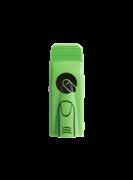
QuantaFlo PAD is an FDA-cleared, non-invasive diagnostic technology that detects early flow volume changes in the upper and lower extremities. This method is more sensitive and can detect PAD even in asymptomatic patients, which is an important capability of the test. Unlike cuff-based ABI testing methods, QuantaFlo is not affected by arterial calcification, which can sometimes lead to inaccurate results in traditional tests.
THE POWER OF NEXT GENERATION POINT OF CARE DIAGNOSTICS


The need for increased access to immediate diagnostics and care has never been highlighted more than during the pandemic.
MDescapes — ISLAND OASIS: THE OCEAN CLUB, A FOUR SEASONS RESORT
Paradise has been found! Literally and perhaps not so coincidentally on the northern shore of Paradise Island in the Bahamas.
4 | PHYSICIANS OFFICE RESOURCE 6 32
TABLE OF CONTENTS
3001
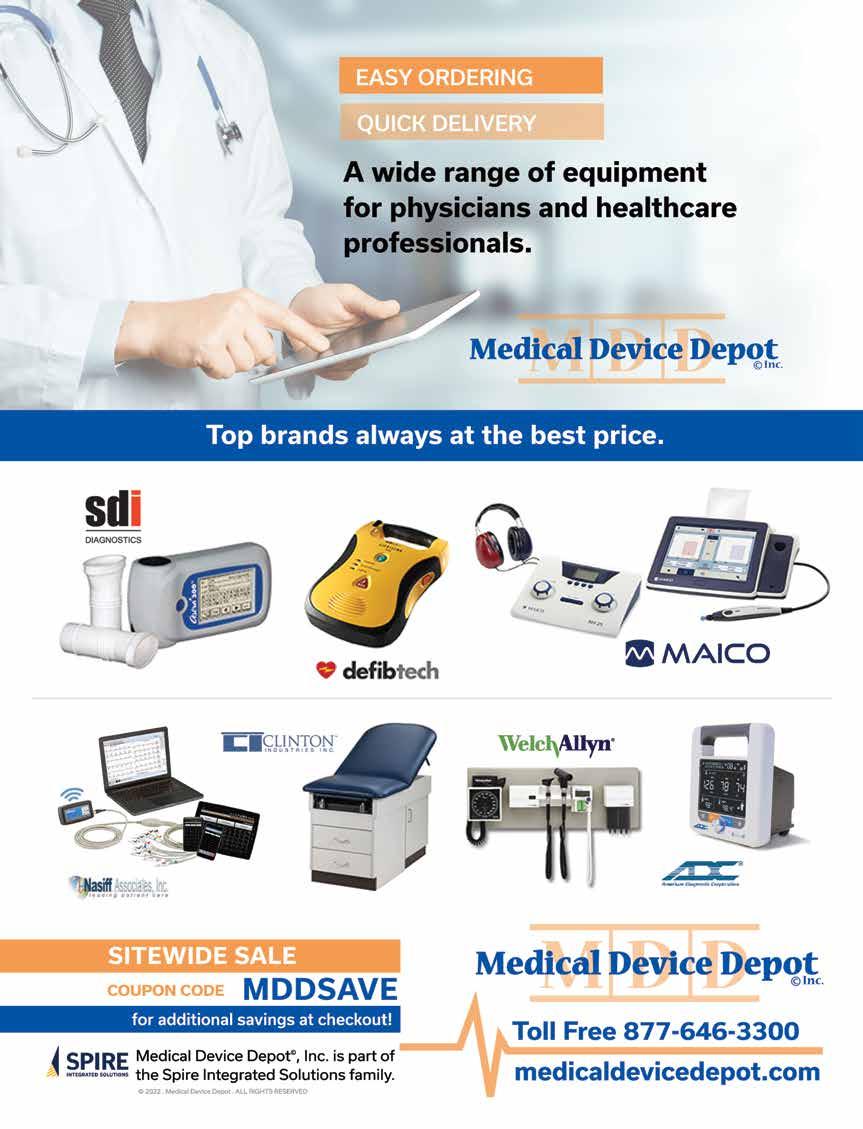
3002 3003
3005 3006 3007 3008
3004
3009
THE POWER OF NEXT GENERATION POINT OF CARE DIAGNOSTICS

6 | PHYSICIANS OFFICE RESOURCE BRIAN K. DUCHATEAU,
PH.D., D(ABMLI)
FEATURE
The need for increased access to immediate diagnostics and care has never been highlighted more than during the pandemic. And one by-product of the pandemic has been the rapid implementation and adoption of innovative testing technologies. These instant health care delivery tools, including next-generation rapid antigen tests have transformed the way we can deliver health care at the point of need, whether that be in hospitals, labs and importantly in community-based settings. The forthcoming generation of rapid antigen tests leverage novel technologies to allow both speed and accuracy at the nexus of action or the point of need where critical split-second medical decisions are made.
The latest point of care testing technologies not only promise accurate and fast results but also serve as a key component in addressing testing access and inequities. The Lancet study released earlier this year “The silent and dangerous inequity around access to COVID-19 testing” explained that POC rapid antigen tests are one of the most promising tools to increase access to testing and address the extreme inequities the pandemic exposed in testing across low- and middle-income countries (LMICs).
And, while rapid diagnostics provide an effective and scalable care delivery model at the point of need, they are also crucial for controlling future infectious outbreaks. Bill Gates, in his recent book, “How to Prevent the Next Pandemic” presents a detailed strategy on what can be done at a global scale to avoid the catastrophic impact of another pandemic. His recommended framework for pandemic prevention and response coordination specifically calls out point of care diagnostics as having untapped potential, which we can apply to disease outbreaks.
If we are to future proof our health system today, we must ensure diagnostic equity—integrating point of care diagnostics into every part of our health system—hospitals, labs, and also pharmacies, schools, and other community settings.
Laboratory-run PCR tests are expensive, required skilled labor to perform and do not guarantee this level of efficiency, especially for care centers in remote communities. Laboratory tests may take days to run, and the facilities are often miles away from community hospitals, not an enabling ecosystem for treatment follow through for people that travel long distances. Additionally, rapid antigen tests also circumvent the “persistent positive” results common to PCR tests, which indicate an infection for an extended period even when the person is likely no longer contagious. Antigen tests offer an advantageous alternative, since a growing body of evidence demonstrate that antigen tests correlate more closely to culture suggesting positive results are more likely to be from active infections. In a study from a group at Johns Hopkins University (Pekosz et. al.), antigen tests demonstrated a higher positive predictive value (90%) than rt-PCR (70%) when compared to culture-positive results. Similar findings were reported by a group at Harvard (Kirby et. al), however their study design went a step further to include both lateral flow as well as microfluidic based rapid antigen test. Their findings showed enhanced sensitivity for the rapid microfluidic immunofluorescence method compared to
the lateral flow antigen tests. This level of specificity empowers our ability to go back to “normal”.
The power of next generation point of care diagnostics was discussed at the recent American Association for Clinical Chemistry (AACC) Annual Conference in Chicago this summer. The discussion presented data-backed insights on the impact of LumiraDx advanced microfluidic technology over lateral flow point-of-care antigen tests, and the role of these rapid immunoassays in response to the COVID-19 pandemic.
LumiraDx, established in 2014, is transforming community-based healthcare by providing fast, accurate, and comprehensive diagnostic information to healthcare providers at the point of need, thereby enabling better medical decisions and improved patient outcomes at a much lower cost.
As the Scientific & Clinical Affairs Vice President at LumiraDx, I spoke alongside Dr. Paul Drain, Associate Professor at the University of Washington in the Departments of Global Health, Medicine (Infectious Diseases), and Epidemiology at the session. Dr. Drain presented his prospective validation study of the LumiraDx severe acute respiratory syndrome coronavirus 2 (SARS-CoV-2) rapid antigen test, which uses a high-sensitivity, microfluidic immunoassay to detect the nucleocapsid protein of SARS-CoV-2 for diagnosing acute coronavirus disease 2019 (COVID-19) in adults and children across point of care settings.
The study showed that, among 512 participants, the LumiraDx SARS-CoV-2 Ag has a 97.6% positive agreement to RT PCR in patients up to 12 days following symptom onset, and 100% PPA up to Ct 33. These findings testify to the effectiveness of rapid, high-sensitivity assay using nasopharyngeal or anterior nasal sampling, offering significant improvements for diagnosing acute SARS-CoV-2 infection in clinic- and community-based settings. Dr. Drain also shared more recent data showing that differences between Delta and Omicron variants did not affect the performance of the LumiraDx SARS-CoV-2 Antigen Test. As we look ahead, immediacy is central to meeting patient care needs and optimizing provider decision making. Given the looming challenges of future pandemics, we should support policies that invest in integrated, scalable diagnostic solutions, which we can deploy rapidly at the point of care, especially in communities where little healthcare infrastructure is present. This will enable effective decision-making at the point of need, increase access to care, save health care costs, and improve patient outcomes.
Brian K. DuChateau, Ph.D., D(ABMLI) is
a board certified clinical laboratory immunologist who received his Ph.D. in immunology and medical microbiology from the University of Wisconsin-Madison and completed a post-doctoral residency in clinical immunology at the Chicago Medical School. Dr. DuChateau has over 20 years of experience as a clinical laboratory director and 12 years of in vitro diagnostics (IVD) experience and currently serves as the LumiraDx Vice President of US Scientific and Clinical Affairs.
2023 · ISSUE 7 | 7
CHEMISTRY ANALYZERS
RX IMOLA
From HORIBA Medical
The RX imola is a cost-effective system that delivers consistent high-quality results. Capable of handling the workload of a medium to high throughout laboratory and a combined throughput of 560 tests per hour, the RX imola provides rapid, comprehensive testing on a small footprint analyzer when it matters most, with direct HbA1c testing capabilities.
View Brochures, Videos & More at POR.io Enter Number 3010 in the Search Area
TOXICOLOGY SCREENING SIMPLIFIED
ABBOTT’S IMMTOX 270 BENCHTOP ANALYZER NOW WITH 14 ASSAYS CLIA CATEGORIZED AS MODERATE COMPLEXITY
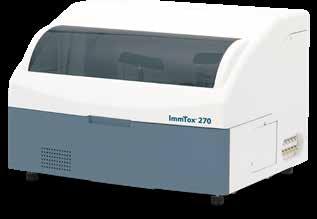
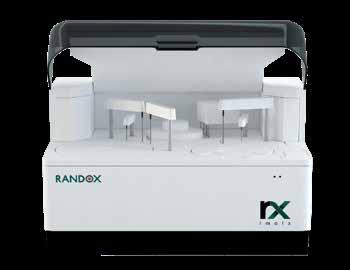
From Abbott
The ImmTox270 benchtop analyzer offers comprehensive toxicology screening solutions for physician offices, treatment centers and independent laboratories.
Broad test menu with over 20 assays to choose from including 14 that are now available as moderately complex. With complete laboratory solutions from consultation to licensure, and compliance the Abbott Clinical Laboratory Solutions team has you covered.
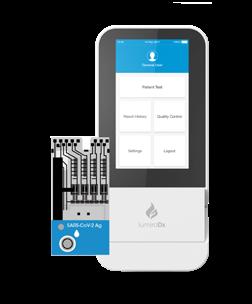
View Brochures, Videos & More at POR.io Enter Number 3011 in the Search Area
3011
COVID-19 TESTING
WHY COMPROMISE? FAST AND RELIABLE RESULTS ARE NOW DELIVERED AT THE POINT
From LumiraDx
OF CARE.
Introducing the next generation in point-of-care diagnostics. With a growing menu of tests, LumiraDx uses a simple process that allows for more time with your patients by using microfluidic technology that delivers results in minutes. Learn more about rapid COVID-19 diagnostic solutions for your physician office at LumiraDx.com.
View Brochures, Videos & More at POR.io Enter Number 3012 in the Search Area
8 | PHYSICIANS OFFICE RESOURCE PRODUCT FOCUS
3010
3012






Learn more at oneLIBTAYO.com © 2023 Regeneron Pharmaceuticals, Inc. All rights reserved. LIB.23.02.0157 03/23 MANY UNIQUE STORIES ONE THERAPY Patient portrayals. See if LIBTAYO may be right for your patients.
3013
COVID-19 TESTING
SOFIA® 2 FLUORESCENT IMMUNOASSAY ANALYZER AND RAPID DIAGNOSTIC TEST KITS
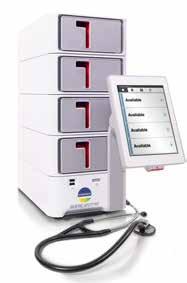
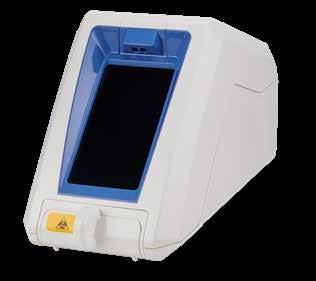
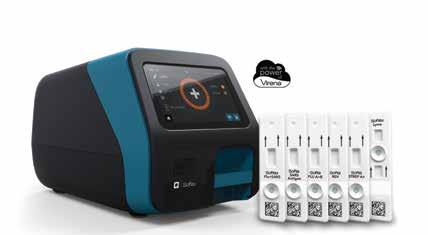
From Quidel
Sofia® 2 Fluorescent Immunoassay Analyzer and Rapid Diagnostic Test Kits Sofia 2 takes rapid testing to a new level. Proven lateral-flow technology and advanced fluorescent chemistry are all integrated into this small benchtop analyzer which can be used in any point-of-care setting. Sofia 2 kits are easy to use and adaptable to any healthcare setting. Excellent performance, objectivity, quality control, LIS capabilities, and an expanding test menu make Sofia 2 the perfect solution for the physician’s office laboratory.
View Brochures, Videos & More at POR.io Enter Number 3013 in the Search Area
FLU AND RESPIRATORY
BIOFIRE SPOTFIRE
From bioMerieux
bioMérieux knows that an evolving world deserves evolved diagnostics. Our latest innovation, the BIOFIRE® SPOTFIRE® Respiratory Solution, is the first FDA-cleared and CLIA-waived COVID-19 testing solution. The BIOFIRE® SPOTFIRE® System is an easy-to-use system that runs the BIOFIRE® SPOTFIRE® Respiratory (R) Panel. Benefits of the SPOTFIRE Respiratory Solution include: 15 respiratory targets on 1 PCR test with results in about 15 minutes; minimal benchtop space with vertical scalability up to four modules; easy to use with an intuitive user interface.
View Brochures, Videos & More at POR.io Enter Number 3014 in the Search Area
3014
ACUCY INFLUENZA A&B TEST
From Sekisui Diagnostics
The Acucy™ Influenza A&B Test is for the rapid, qualitative detection of influenza A and B viral nucleoprotein antigens from both nasal and nasopharyngeal swabs. Utilizing the Acucy™ Reader in either the point-of-care or laboratory setting, workflow flexibility is achieved with both Read Now and Walk Away features. The combination provides clinicians with standardized and definitive result interpretation.
View Brochures, Videos & More at POR.io Enter Number 3015 in the Search Area 3015
10 | PHYSICIANS OFFICE RESOURCE
PRODUCT FOCUS
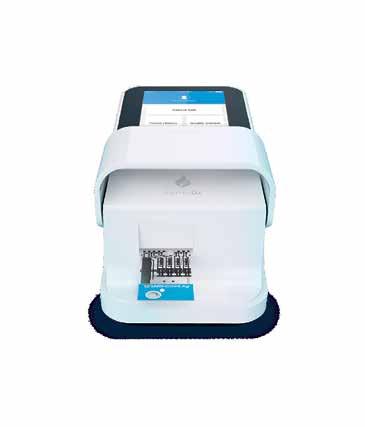
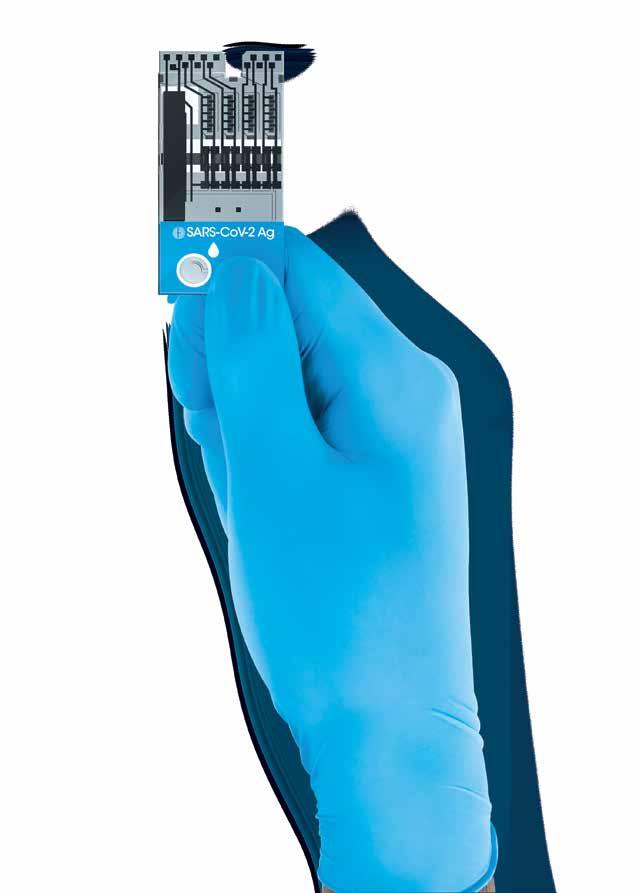
3016
3017
FLU AND RESPIRATORY
OSOM ULTRA PLUS FLU A&B TEST
From Sekisui Diagnostics
Stronger Clinical Performance Takes Lateral Flow Testing To The Next Level. Providing superior rapid results at the point-of-care. Fast, easy, cost effective so you can test and treat in one visit.
• High Performance- Equivalent or exceeding the performance of reader devices, without the need for an instrument
• Results in 10 minutes
• OSOM® Custom Care- Exceptional Support/Training by licensed medical technologists and experienced healthcare professionals
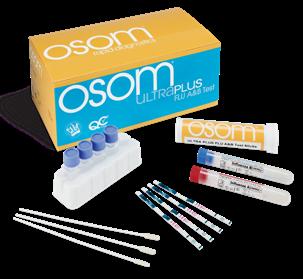
• Made in the USA
View Brochures, Videos & More at POR.io
Enter Number 3017 in the Search Area
PERIPHERAL ARTERIAL DISEASE
QUANTAFLO® HD
From Semler Scientific
The QuantaFlo® HD application assists in the early detection of Heart Dysfunction (HD). As published in the Journal of Preventive Medicine, QuantaFlo HD showed a statistically significant correlation with cardiac echocardiography, which is a gold standard for diagnosing heart failure.1 The test is highly sensitive, able to detect even asymptomatic HD, and can be performed in the outpatient clinic or the home setting in approximately 5 mins. Results are available immediately and graded as either positive or negative for HD allowing for improved patient selection for echocardiography.
1. Howell, S. C., & Master, R. C. (2023). Clinical Evaluation of Volume Plethysmography as an Aid for Diagnosis of Heart Failure in the Primary Care Setting. Journal of Preventive Medicine, 8(2). https://doi.org/https://preventive-medicine.imedpub.com/clinical-evaluation-of-volumeplethysmography-as-an-aid-for-diagnosis-of-heart-failure-in-the-primary-care-setting.pdf
View Brochures, Videos & More at POR.io
Enter Number 3018 in the Search Area
MD6300 MICRO SPIROMETER
3018
SPIROMETRY
FULL FUNCTION LOW COST SPIROMETER
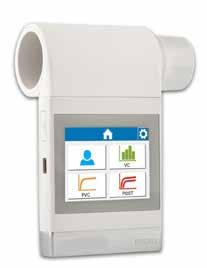
From Mirco Direct
3019
The Micro Spirometer is the newest offering in the Micro Direct spirometer line. Specifically designed for situations where low cost, precision spirometry measurements are required, the Micro Spirometer is lightweight and portable making it suitable for the physician office. The Micro Spirometer features a large color touch screen that is icon driven. The Micro Spirometer is supplied with Device Studio. A PC software for producing printouts of tests results or for creating PDF reports for attachment to the patients’ EMR file.
View Brochures, Videos & More at POR.io
Enter Number 3019 in the Search Area
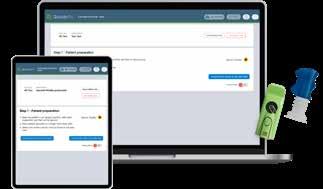
12 | PHYSICIANS OFFICE RESOURCE PRODUCT FOCUS
Meet the Quadruple Aim in Diabetes Care with In-office HbA1c and uACR
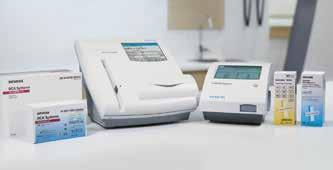
Better outcomes. Lower costs. Better patient experience. Better clinician experience.

Comprehensive diabetes-management solutions at the point-of-care
Gain key insights into your patient’s current status and drive guideline recommended test adherence:
DCA Vantage® Analyzer
CLIA-waived HbA1c
• Rapid assessment for glycemic control
CLINITEK Status® Connect System
CLIA-waived analyzer for routine urinalysis
• Rapid kidney health assessment:
CLINITEK® Microalbumin 2 Strip Albumin-to-creatinine ratio (ACR)
Total U.S. Population with Diabetes
The Prevalence of Diabetes Among U.S. Adults is on the Rise1
Help your patients reverse the trend
Customize your patient consultations to enhance physician-patient partnership toward improved outcomes. siemens-healthineers.us/chronicdisease
POC-22-NAM-3308
2015 11.1% 35,644,000 2020 13.0% 43,271,000 2030 Projected 15.3% 54,913,000 54% Increase 3020 3021
1. Rowley, William R et al. “Diabetes 2030: Insights from Yesterday, Today, and Future Trends.” Population health management vol. 20,1 (2017): 6-12. doi:10.1089/pop.2015.0181.
BATTLE TESTED IN EOS DISEASE
IMPORTANT SAFETY INFORMATION
CONTRAINDICATIONS
NUCALA should not be administered to patients with a history of hypersensitivity to mepolizumab or excipients in the formulation.
WARNINGS AND PRECAUTIONS
Hypersensitivity Reactions
Hypersensitivity reactions (eg, anaphylaxis, angioedema, bronchospasm, hypotension, urticaria, rash) have occurred with NUCALA. These reactions generally occur within hours of administration but can have a delayed onset (ie, days). If a hypersensitivity reaction occurs, discontinue NUCALA.

SEVERE EOSINOPHILIC ASTHMA (SEA)
• add-on maintenance treatment of patients 6+ with SEA. Not for acute bronchospasm or status asthmaticus.
CHRONIC RHINOSINUSITIS WITH NASAL POLYPS (CRSwNP)
• add-on maintenance treatment of CRSwNP in patients 18+ with inadequate response to nasal corticosteroids.

IMPORTANT SAFETY INFORMATION (cont’d)

WARNINGS AND PRECAUTIONS (cont’d)




Acute Asthma Symptoms or Deteriorating Disease
EOSINOPHILIC GRANULOMATOSIS WITH POLYANGIITIS (EGPA)
• treatment of adult patients with EGPA.
HYPEREOSINOPHILIC SYNDROME (HES)
• treatment of patients aged 12+ with HES for ≥6 months without an identifiable non-hematologic secondary cause.
NUCALA should not be used to treat acute asthma symptoms, acute exacerbations, or acute bronchospasm.
Opportunistic Infections: Herpes Zoster

Herpes zoster infections have occurred in patients receiving NUCALA. Consider vaccination if medically appropriate.
Reduction of Corticosteroid Dosage

Do not discontinue systemic or inhaled corticosteroids abruptly upon initiation of therapy with NUCALA. Decreases in corticosteroid doses, if appropriate, should be gradual and under the direct supervision of a physician. Reduction in corticosteroid dose may be associated with systemic withdrawal symptoms and/or unmask conditions previously suppressed by systemic corticosteroid therapy.
Parasitic (Helminth) Infection
Treat patients with pre-existing helminth infections before initiating therapy with NUCALA. If patients become infected while receiving NUCALA and do not respond to anti-helminth treatment, discontinue NUCALA until infection resolves.
ADVERSE REACTIONS
Most common adverse reactions (≥5%) in patients receiving NUCALA:
• Severe asthma trials: headache, injection site reaction, back pain, fatigue
• CRSwNP trial: oropharyngeal pain, arthralgia
• EGPA and HES trials (300 mg of NUCALA): no additional adverse reactions were identified to those reported in severe asthma clinical trials
Systemic reactions, including hypersensitivity, occurred in clinical trials in patients receiving NUCALA. Manifestations included rash, pruritus, headache, myalgia, flushing, urticaria, erythema, fatigue, hypertension, warm sensation in trunk and neck, cold extremities, dyspnea, stridor, angioedema, and multifocal skin reaction. A majority of systemic reactions were experienced the day of dosing.
USE IN SPECIFIC POPULATIONS
A pregnancy exposure registry monitors pregnancy outcomes in women with asthma exposed to NUCALA during pregnancy. To enroll call 1-877-311-8972 or visit www.mothertobaby.org/asthma.
The data on pregnancy exposures are insu cient to inform on drug-associated risk. Monoclonal antibodies, such as mepolizumab, are transported across the placenta in a linear fashion as the pregnancy progresses; therefore, potential e ects on a fetus are likely to be greater during the second and third trimesters.
Trademarks
Please see Brief Summary of Prescribing Information for NUCALA on the following pages. ©2022 GSK or licensor. MPLJRNA220006 September 2022 Produced in USA.
are owned by or licensed to the GSK group of companies.
NucalaBattleTested.com to learn more
Visit
With proven results across 4 indications— our track record stands out
NUCALA (mepolizumab) for injection, for subcutaneous use
NUCALA (mepolizumab) injection, for subcutaneous use
The following is a brief summary only; see full prescribing information for complete product information.
1 INDICATIONS AND USAGE
1.1 Maintenance Treatment of Severe Asthma
NUCALA is indicated for the add-on maintenance treatment of adult and pediatric patients aged 6 years and older with severe asthma and with an eosinophilic phenotype [see Use in Specific Populations (8.4) and Clinical Studies (14.1) of full prescribing information]
Limitations of Use
NUCALA is not indicated for the relief of acute bronchospasm or status asthmaticus.
1.2 Maintenance Treatment of Chronic Rhinosinusitis with Nasal Polyps
NUCALA is indicated for the add-on maintenance treatment of chronic rhinosinusitis with nasal polyps (CRSwNP) in adult patients 18 years of age and older with inadequate response to nasal corticosteroids.
1.3 Eosinophilic Granulomatosis with Polyangiitis
NUCALA is indicated for the treatment of adult patients with eosinophilic granulomatosis with polyangiitis (EGPA).
1.4 Hypereosinophilic Syndrome
NUCALA is indicated for the treatment of adult and pediatric patients aged 12 years and older with hypereosinophilic syndrome (HES) for ≥6 months without an identifiable non-hematologic secondary cause.
4 CONTRAINDICATIONS
NUCALA is contraindicated in patients with a history of hypersensitivity to mepolizumab or excipients in the formulation [see Warnings and Precautions (5.1) and Description (11) of full prescribing information].
5 WARNINGS AND PRECAUTIONS
5.1 Hypersensitivity Reactions
Hypersensitivity reactions (e.g., anaphylaxis, angioedema, bronchospasm, hypotension, urticaria, rash) have occurred following administration of NUCALA. These reactions generally occur within hours of administration, but in some instances can have a delayed onset (i.e., days). In the event of a hypersensitivity reaction, NUCALA should be discontinued [see Contraindications (4)]
5.2 Acute Asthma Symptoms or Deteriorating Disease
NUCALA should not be used to treat acute asthma symptoms or acute exacerbations. Do not use NUCALA to treat acute bronchospasm or status asthmaticus. Patients should seek medical advice if their asthma remains uncontrolled or worsens after initiation of treatment with NUCALA.
5.3 Opportunistic Infections: Herpes Zoster
Herpes zoster has occurred in subjects receiving NUCALA 100 mg in controlled clinical trials [see Adverse Reactions (6.1)]. Consider vaccination if medically appropriate.
5.4 Reduction of Corticosteroid Dosage
Do not discontinue systemic or inhaled corticosteroids (ICS) abruptly upon initiation of therapy with NUCALA. Reductions in corticosteroid dosage, if appropriate, should be gradual and performed under the direct supervision of a physician. Reduction in corticosteroid dosage may be associated with systemic withdrawal symptoms and/or unmask conditions previously suppressed by systemic corticosteroid therapy.
5.5 Parasitic (Helminth) Infection
Eosinophils may be involved in the immunological response to some helminth infections. Patients with known parasitic infections were excluded from participation in clinical trials. It is unknown if NUCALA will influence a patient’s response against parasitic infections. Treat patients with pre-existing helminth infections before initiating therapy with NUCALA. If patients become infected while receiving treatment with NUCALA and do not respond to anti-helminth treatment, discontinue treatment with NUCALA until infection resolves.
6 ADVERSE REACTIONS
The following adverse reactions are described in greater detail in other sections:
• Hypersensitivity reactions [see Warnings and Precautions (5.1)]
• Opportunistic infections: herpes zoster [see Warnings and Precautions (5.3)] Because clinical trials are conducted under widely varying conditions, adverse reaction rates observed in the clinical trials of a drug cannot be directly compared with rates in the clinical trials of another drug and may not reflect the rates observed in practice.
6.1 Clinical Trials Experience in Severe Asthma
Adult and Adolescent
Patients Aged 12 Years and Older
A total of 1,327 patients with severe asthma were evaluated in 3 randomized, placebo-controlled, multicenter trials of 24 to 52 weeks’ duration (Trial 1, NCT01000506; Trial 2, NCT01691521; and Trial 3, NCT01691508). Of these, 1,192 had a history of 2 or more exacerbations in the year prior to enrollment despite regular use of high-dose ICS plus additional controller(s) (Trials 1 and 2), and 135 patients required daily oral corticosteroids (OCS) in addition to regular use of highdose ICS plus additional controller(s) to maintain asthma control (Trial 3). All
patients had markers of eosinophilic airway inflammation [see Clinical Studies (14.1) of full prescribing information]. Of the patients enrolled, 59% were female, 85% were White, and ages ranged from 12 to 82 years. Mepolizumab was administered subcutaneously or intravenously once every 4 weeks; 263 patients received NUCALA (mepolizumab 100 mg subcutaneous) for at least 24 weeks. Serious adverse events that occurred in more than 1 patient and in a greater percentage of patients receiving NUCALA 100 mg (n = 263) than placebo (n = 257) included 1 event, herpes zoster (2 patients vs. 0 patients, respectively). Approximately 2% of patients receiving NUCALA 100 mg withdrew from clinical trials due to adverse events compared with 3% of patients receiving placebo.
The incidence of adverse reactions in the first 24 weeks of treatment in the 2 confirmatory efficacy and safety trials (Trials 2 and 3) with NUCALA 100 mg is shown in Table 1.
Table 1. Adverse Reactions with NUCALA with ≥3% Incidence and More Common than Placebo in Patients with Severe Asthma (Trials 2 and 3)
Adverse Reaction
52-Week Trial: Adverse reactions from Trial 1 with 52 weeks of treatment with mepolizumab 75 mg intravenous (IV) (n = 153) or placebo (n = 155) and with ≥3% incidence and more common than placebo and not shown in Table 1 were: abdominal pain, allergic rhinitis, asthenia, bronchitis, cystitis, dizziness, dyspnea, ear infection, gastroenteritis, lower respiratory tract infection, musculoskeletal pain, nasal congestion, nasopharyngitis, nausea, pharyngitis, pyrexia, rash, toothache, viral infection, viral respiratory tract infection, and vomiting. In addition, 3 cases of herpes zoster occurred in patients receiving mepolizumab 75 mg IV compared with 2 patients in the placebo group.
Systemic Reactions, including Hypersensitivity Reactions: In Trials 1, 2, and 3 described above, the percentage of patients who experienced systemic (allergic and non-allergic) reactions was 3% in the group receiving NUCALA 100 mg and 5% in the placebo group. Systemic allergic/hypersensitivity reactions were reported by 1% of patients in the group receiving NUCALA 100 mg and 2% of patients in the placebo group. The most commonly reported manifestations of systemic allergic/ hypersensitivity reactions reported in the group receiving NUCALA 100 mg included rash, pruritus, headache, and myalgia. Systemic non-allergic reactions were reported by 2% of patients in the group receiving NUCALA 100 mg and 3% of patients in the placebo group. The most commonly reported manifestations of systemic non-allergic reactions reported in the group receiving NUCALA 100 mg included rash, flushing, and myalgia. A majority of the systemic reactions in patients receiving NUCALA 100 mg (5/7) were experienced on the day of dosing.
Injection Site Reactions : Injection site reactions (e.g., pain, erythema, swelling, itching, burning sensation) occurred at a rate of 8% in patients receiving NUCALA 100 mg compared with 3% in patients receiving placebo.
Long-term Safety : Nine hundred ninety-eight patients received NUCALA 100 mg in ongoing open-label extension studies, during which additional cases of herpes zoster were reported. The overall adverse event profile has been similar to the asthma trials described above.
Pediatric Patients Aged 6 to 11 Years
The safety data for NUCALA is based upon 1 open-label clinical trial that enrolled 36 patients with severe asthma aged 6 to 11 years. Patients received 40 mg (for those weighing <40 kg) or 100 mg (for those weighing ≥40 kg) of NUCALA administered subcutaneously once every 4 weeks. Patients received NUCALA for 12 weeks (initial short phase). After a treatment interruption of 8 weeks, 30 patients received NUCALA for a further 52 weeks (long phase). The adverse reaction profile for patients aged 6 to 11 years was similar to that observed in patients aged 12 years and older.
6.2 Clinical Trials Experience in Chronic Rhinosinusitis with Nasal Polyps
A total of 407 patients with CRSwNP were evaluated in 1 randomized, placebocontrolled, multicenter, 52-week treatment trial. Patients received NUCALA 100 mg or placebo subcutaneously once every 4 weeks. Patients had recurrent CRSwNP with a history of prior surgery and were on nasal corticosteroids for at least 8 weeks prior to screening [see Clinical Studies (14.2) of full prescribing information]. Of the patients enrolled, 35% were female, 93% were White, and ages ranged from 18 to 82 years. Approximately 2% of patients receiving NUCALA (continued on next page)
NUCALA (Mepolizumab 100 mg Subcutaneous) (n = 263) % Placebo (n = 257) % Headache 19 18 Injection site reaction 8 3 Back pain 5 4 Fatigue 5 4 Influenza 3 2 Urinary tract infection 3 2 Abdominal pain upper 3 2 Pruritus 3 2 Eczema 3 <1 Muscle spasms 3 <1
BRIEF SUMMARY
6 ADVERSE REACTIONS (cont’d)
100 mg withdrew from study treatment due to adverse events compared with 2% of patients receiving placebo.
Table 2 summarizes adverse reactions that occurred in ≥3% of NUCALA-treated patients and more frequently than in patients treated with placebo in the CRSwNP trial.
Table 2. Adverse Reactions with NUCALA with ≥3% Incidence and More Common than Placebo in Patients with CRSwNP
Injection Site Reactions
Injection site reactions (e.g., burning, itching) occurred at a rate of 7% in patients receiving 300 mg of NUCALA compared with 4% in patients receiving placebo.
6.5 Immunogenicity
In adult and adolescent patients with severe asthma receiving NUCALA 100 mg, 15/260 (6%) had detectable anti-mepolizumab antibodies. Neutralizing antibodies were detected in 1 patient with asthma receiving NUCALA 100 mg. Antimepolizumab antibodies slightly increased (approximately 20%) the clearance of mepolizumab. There was no evidence of a correlation between anti-mepolizumab antibody titers and change in eosinophil level. The clinical relevance of the presence of anti-mepolizumab antibodies is not known. In the clinical trial of children aged 6 to 11 years with severe asthma receiving NUCALA 40 or 100 mg, 2/35 (6%) had detectable anti-mepolizumab antibodies during the initial short phase of the trial. No children had detectable anti-mepolizumab antibodies during the long phase of the trial.
In patients with CRSwNP receiving NUCALA 100 mg, 6/196 (3%) had detectable anti-mepolizumab antibodies. No neutralizing antibodies were detected in any patients with CRSwNP.
In patients with EGPA receiving 300 mg of NUCALA, 1/68 (<2%) had detectable anti-mepolizumab antibodies. No neutralizing antibodies were detected in any patients with EGPA.
In adult and adolescent patients with HES receiving 300 mg of NUCALA, 1/53 (2%) had detectable anti-mepolizumab antibodies. No neutralizing antibodies were detected in any patients with HES.
CRSwNP = Chronic Rhinosinusitis with Nasal Polyps.
Systemic Reactions, including Hypersensitivity Reactions
In the 52-week trial, the percentage of patients who experienced systemic (allergic [type I hypersensitivity] and other) reactions was <1% in the group receiving NUCALA 100 mg and <1% in the placebo group. Systemic allergic (type I hypersensitivity) reactions were reported by <1% of patients in the group receiving NUCALA 100 mg and no patients in the placebo group. The manifestations of systemic allergic (type I hypersensitivity) reactions included urticaria, erythema, and rash and 1 of the 3 reactions occurred on the day of dosing. Other systemic reactions were reported by no patients in the group receiving NUCALA 100 mg and <1% of patients in the placebo group.
Injection Site Reactions
Injection site reactions (e.g., erythema, pruritus) occurred at a rate of 2% in patients receiving NUCALA 100 mg compared with <1% in patients receiving placebo.
6.3 Clinical Trials Experience in Eosinophilic Granulomatosis with Polyangiitis
A total of 136 patients with EGPA were evaluated in 1 randomized, placebo-controlled, multicenter, 52-week treatment trial. Patients received 300 mg of NUCALA or placebo subcutaneously once every 4 weeks. Patients enrolled had a diagnosis of EGPA for at least 6 months prior to enrollment with a history of relapsing or refractory disease and were on a stable dosage of oral prednisolone or prednisone of greater than or equal to 7.5 mg/day (but not greater than 50 mg/day) for at least 4 weeks prior to enrollment [see Clinical Studies (14.3) of full prescribing information]. Of the patients enrolled, 59% were female, 92% were White, and ages ranged from 20 to 71 years. No additional adverse reactions were identified to those reported in the severe asthma trials.
Systemic Reactions, including Hypersensitivity Reactions
In the 52-week trial, the percentage of patients who experienced systemic (allergic and non-allergic) reactions was 6% in the group receiving 300 mg of NUCALA and 1% in the placebo group. Systemic allergic/hypersensitivity reactions were reported by 4% of patients in the group receiving 300 mg of NUCALA and 1% of patients in the placebo group. The manifestations of systemic allergic/hypersensitivity reactions reported in the group receiving 300 mg of NUCALA included rash, pruritus, flushing, fatigue, hypertension, warm sensation in trunk and neck, cold extremities, dyspnea, and stridor. Systemic non-allergic reactions were reported by 1 (1%) patient in the group receiving 300 mg of NUCALA and no patients in the placebo group. The reported manifestation of systemic non-allergic reactions reported in the group receiving 300 mg of NUCALA was angioedema. Half of the systemic reactions in patients receiving 300 mg of NUCALA (2/4) were experienced on the day of dosing.
Injection Site Reactions
Injection site reactions (e.g., pain, erythema, swelling) occurred at a rate of 15% in patients receiving 300 mg of NUCALA compared with 13% in patients receiving placebo.
6.4 Clinical Trials Experience in Hypereosinophilic Syndrome
A total of 108 adult and adolescent patients aged 12 years and older with HES were evaluated in a randomized, placebo-controlled, multicenter, 32-week treatment trial. Patients with non-hematologic secondary HES or FIP1L1-PDGFR kinase-positive HES were excluded from the trial. Patients received 300 mg of NUCALA or placebo subcutaneously once every 4 weeks. Patients must have been on a stable dose of background HES therapy for the 4 weeks prior to randomization [see Clinical Studies (14.4) of full prescribing information]. Of the patients enrolled, 53% were female, 93% were White, and ages ranged from 12 to 82 years. No additional adverse reactions were identified to those reported in the severe asthma trials. Systemic Reactions, including Hypersensitivity Reactions
In the trial, no systemic allergic (type I hypersensitivity) reactions were reported. Other systemic reactions were reported by 1 (2%) patient in the group receiving 300 mg of NUCALA and no patients in the placebo group. The reported manifestation of other systemic reaction was multifocal skin reaction experienced on the day of dosing.
The reported frequency of anti-mepolizumab antibodies may underestimate the actual frequency due to lower assay sensitivity in the presence of high drug concentration. The data reflect the percentage of patients whose test results were positive for antibodies to mepolizumab in specific assays. The observed incidence of antibody positivity in an assay is highly dependent on several factors, including assay sensitivity and specificity, assay methodology, sample handling, timing of sample collection, concomitant medications, and underlying disease.
6.6 Postmarketing Experience
In addition to adverse reactions reported from clinical trials, the following adverse reactions have been identified during postapproval use of NUCALA. Because these reactions are reported voluntarily from a population of uncertain size, it is not always possible to reliably estimate their frequency or establish a causal relationship to drug exposure. These events have been chosen for inclusion due to either their seriousness, frequency of reporting, or causal connection to NUCALA or a combination of these factors.
Immune System Disorders
Hypersensitivity reactions, including anaphylaxis.
7 DRUG INTERACTIONS
Formal drug interaction trials have not been performed with NUCALA.
8 USE IN SPECIFIC POPULATIONS
8.1 Pregnancy Pregnancy Exposure Registry
There is a pregnancy exposure registry that monitors pregnancy outcomes in women with asthma exposed to NUCALA during pregnancy. Healthcare providers can enroll patients or encourage patients to enroll themselves by calling 1-877311-8972 or visiting www.mothertobaby.org/asthma.
Risk Summary
The data on pregnancy exposure are insufficient to inform on drug-associated risk. Monoclonal antibodies, such as mepolizumab, are transported across the placenta in a linear fashion as pregnancy progresses; therefore, potential effects on a fetus are likely to be greater during the second and third trimester of pregnancy. In a prenatal and postnatal development study conducted in cynomolgus monkeys, there was no evidence of fetal harm with IV administration of mepolizumab throughout pregnancy at doses that produced exposures up to approximately 9 times the exposure at the maximum recommended human dose (MRHD) of 300 mg subcutaneous (see Data). In the U.S. general population, the estimated background risk of major birth defects and miscarriage in clinically recognized pregnancies is 2% to 4% and 15% to 20%, respectively.
Clinical Considerations
Disease-Associated Maternal and/or Embryofetal Risk: In women with poorly or moderately controlled asthma, evidence demonstrates that there is an increased risk of preeclampsia in the mother and prematurity, low birth weight, and small for gestational age in the neonate. The level of asthma control should be closely monitored in pregnant women and treatment adjusted as necessary to maintain optimal control.
Data
Animal Data: In a prenatal and postnatal development study, pregnant cynomolgus monkeys received mepolizumab from gestation Days 20 to 140 at doses that produced exposures up to approximately 9 times that achieved with the MRHD (on an AUC basis with maternal IV doses up to 100 mg/kg once every 4 weeks). Mepolizumab did not elicit adverse effects on fetal or neonatal growth (including immune function) up to 9 months after birth. Examinations for internal or skeletal malformations were not performed. Mepolizumab crossed the placenta in cynomolgus monkeys. Concentrations of mepolizumab were approximately 2.4 times higher in infants than in mothers up to Day 178 postpartum. Levels of mepolizumab in milk were ≤0.5% of maternal serum concentration. In a fertility, early embryonic, and embryofetal development study, pregnant CD-1 mice received an analogous antibody, which inhibits the activity of murine interleukin-5 (IL-5), at an IV dose of 50 mg/kg once per week throughout gestation.
(continued on next page)
Adverse Reaction NUCALA (Mepolizumab 100 mg Subcutaneous) (n = 206) % Placebo (n = 201) % Oropharyngeal pain 8 5 Arthralgia 6 2 Abdominal Pain Upper 3 2 Diarrhea 3 2 Pyrexia 3 2 Nasal dryness 3 <1 Rash 3 <1
SPECIFIC POPULATIONS (cont’d)
The analogous antibody was not teratogenic in mice. Embryofetal development of IL-5–deficient mice has been reported to be generally unaffected relative to wild-type mice.
8.2 Lactation
Risk Summary
There is no information regarding the presence of mepolizumab in human milk, the effects on the breastfed infant, or the effects on milk production. However, mepolizumab is a humanized monoclonal antibody (IgG1 kappa), and immunoglobulin G (IgG) is present in human milk in small amounts. Mepolizumab was present in the milk of cynomolgus monkeys postpartum following dosing during pregnancy [see Use in Specific Populations (8.1)]. The developmental and health benefits of breastfeeding should be considered along with the mother’s clinical need for NUCALA and any potential adverse effects on the breastfed infant from mepolizumab or from the underlying maternal condition.
8.4 Pediatric Use
Severe Asthma
The safety and efficacy of NUCALA for severe asthma, and with an eosinophilic phenotype, have been established in pediatric patients aged 6 years and older. Use of NUCALA in adolescents aged 12 to 17 years is supported by evidence from adequate and well-controlled trials in adults and adolescents. A total of 28 adolescents aged 12 to 17 years with severe asthma were enrolled in the Phase 3 asthma trials. Of these, 25 were enrolled in the 32-week exacerbation trial (Trial 2, NCT01691521) and had a mean age of 14.8 years. Patients had a history of 2 or more exacerbations in the previous year despite regular use of medium- or high-dose ICS plus additional controller(s) with or without OCS and had blood eosinophils of ≥150 cells/mcL at screening or ≥300 cells/mcL within 12 months prior to enrollment. [See Clinical Studies (14.1) of full prescribing information.] Patients had a reduction in the rate of exacerbations that trended in favor of NUCALA. Of the 19 adolescents who received NUCALA, 9 received 100 mg and the mean apparent clearance in these patients was 35% less than that of adults. The safety profile observed in adolescents was generally similar to that of the overall population in the Phase 3 studies [see Adverse Reactions (6.1)]
Use of NUCALA in pediatric patients aged 6 to 11 years with severe asthma, and with an eosinophilic phenotype, is supported by evidence from adequate and well-controlled trials in adults and adolescents with additional pharmacokinetic, pharmacodynamic, and safety data in children aged 6 to 11 years. A single, open-label clinical trial (NCT02377427) was conducted in 36 children aged 6 to 11 years (mean age: 8.6 years, 31% female) with severe asthma. Enrollment criteria were the same as for adolescents in the 32-week exacerbation trial (Trial 2). Based upon the pharmacokinetic data from this trial, a dose of 40 mg subcutaneous every 4 weeks was determined to have similar exposure to adults and adolescents administered a dose of 100 mg SC [see Clinical Pharmacology (12.3) of full prescribing information]
The effectiveness of NUCALA in pediatric patients aged 6 to 11 years is extrapolated from efficacy in adults and adolescents with support from pharmacokinetic analyses showing similar drug exposure levels for 40 mg administered subcutaneously every 4 weeks in children aged 6 to 11 years compared with adults and adolescents [see Clinical Pharmacology (12.3) of full prescribing information]. The safety profile and pharmacodynamic response observed in this trial for children aged 6 to 11 years were similar to that seen in adults and adolescents [see Adverse Reactions (6.1), Clinical Pharmacology (12.2) of full prescribing information]
The safety and effectiveness in pediatric patients aged younger than 6 years with severe asthma have not been established.
Chronic Rhinosinusitis with Nasal Polyps
The safety and effectiveness in patients aged younger than 18 years with CRSwNP have not been established.
Eosinophilic
Granulomatosis with Polyangiitis
The safety and effectiveness in patients aged younger than 18 years with EGPA have not been established.
Hypereosinophilic Syndrome
The safety and effectiveness of NUCALA for HES have been established in adolescent patients aged 12 years and older. The safety and effectiveness in pediatric patients aged younger than 12 years with HES have not been established. Use of NUCALA for this indication is supported by evidence from an adequate and well-controlled study (NCT02836496) in adults and adolescents and an open-label extension study (NCT03306043). One adolescent received NUCALA during the controlled study and this patient and an additional 3 adolescents received NUCALA during the open-label extension study [see Clinical Studies (14.4) of full prescribing information]. The 1 adolescent treated with NUCALA in the 32-week trial did not have a HES flare or an adverse event reported. All adolescents received 300 mg of NUCALA for 20 weeks in the open-label extension.
8.5 Geriatric Use
Clinical trials of NUCALA did not include sufficient numbers of patients aged 65 years and older that received NUCALA (n = 79) to determine whether they respond differently from younger patients. Other reported clinical experience has not identified differences in responses between the elderly and younger patients. In general, dose selection for an elderly patient should be cautious, usually starting at the low end of the dosing range, reflecting the greater frequency of decreased hepatic, renal, or cardiac function and of concomitant disease or other drug therapy. Based on available data, no adjustment of the dosage of NUCALA in geriatric patients is necessary, but greater sensitivity in some older individuals cannot be ruled out.
10 OVERDOSAGE
There is no specific treatment for an overdose with mepolizumab. If overdose occurs, the patient should be treated supportively with appropriate monitoring as necessary.
17 PATIENT COUNSELING INFORMATION
Advise the patient to read the FDA-approved patient labeling (Patient Information and Instructions for Use).
Hypersensitivity Reactions
Inform patients that hypersensitivity reactions (e.g., anaphylaxis, angioedema, bronchospasm, hypotension, urticaria, rash) have occurred after administration of NUCALA. Instruct patients to contact their physicians if such reactions occur.
Not for Acute Symptoms or Deteriorating Disease
Inform patients that NUCALA does not treat acute asthma symptoms or acute exacerbations. Inform patients to seek medical advice if their asthma remains uncontrolled or worsens after initiation of treatment with NUCALA.
Opportunistic Infections: Herpes Zoster
Inform patients that herpes zoster infections have occurred in patients receiving NUCALA and where medically appropriate, inform patients that vaccination should be considered.
Reduction of Corticosteroid Dosage
Inform patients to not discontinue systemic or inhaled corticosteroids except under the direct supervision of a physician. Inform patients that reduction in corticosteroid dose may be associated with systemic withdrawal symptoms and/ or unmask conditions previously suppressed by systemic corticosteroid therapy.
Pregnancy Exposure Registry
Inform women there is a pregnancy exposure registry that monitors pregnancy outcomes in women with asthma exposed to NUCALA during pregnancy and that they can enroll in the Pregnancy Exposure Registry by calling 1-877-311-8972 or by visiting www.mothertobaby.org/asthma [see Use in Specific Populations (8.1)] Trademarks are owned by or licensed to the GSK group of companies.
Manufactured by GlaxoSmithKline LLC
Philadelphia, PA 19112
U.S. License Number 1727
Distributed by
GlaxoSmithKline
Research Triangle Park, NC 27709
©2022 GSK group of companies or its licensor.
Revised: 1/2022
©2022 GSK or licensor.
MPLJRNA220006 September 2022
Produced in USA.
NCL:9BRS
8 USE
IN
3022
SPIROMETRY
MD6800 PNEUMOTRAC SPIROMETER A POWERFUL SOLUTION FOR PC-BASED SPIROMETRY
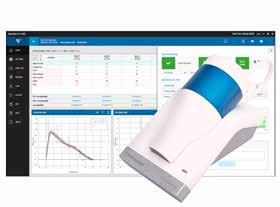
From Micro Direct
The Pneumotrac connects to your PC by USB and captures reliable tests results immediately using the Spirotrac 6 software. These results can be printed or shared easily with compatible EMR systems. The Pneumotrac features a highly accurate, extremely stable Fleisch pneumotrach and meets the latest 2019 ATS/ERS standardization of spirometry ensuring testing meets the most upto-date guidelines. Real-time curves and new animated incentives encourage maximal patient performance and obtain prompt quality feedback using the latest test session/session acceptability, usability and repeatability criteria.
View Brochures, Videos & More at POR.io
Enter Number 3022 in the Search Area
MD6000 ALPHA SPIROMETER THE FUTURE OF DESKTOP SPIROMETRY
From Micro Direct
The Alpha features a highly accurate, extremely stable Fleisch pneumotrach and meets the latest 2019 ATS/ERS standardization of spirometry ensuring testing meets the most up-to-date guidelines. Performing a test is very easy using the large icon driven touch screen. A test quality grading system and live testing prompts give you confidence and peace of mind when performing the test. Reports are printed instantly using the fast, integrated printer or obtain an 8.5” x 11” printout via Device Studio software that is included with the Alpha.
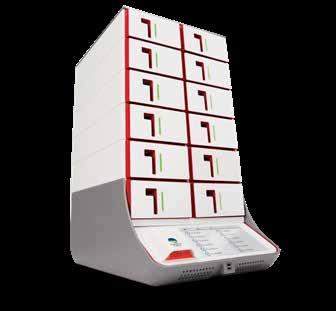
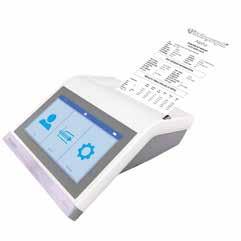
View Brochures, Videos & More at POR.io
Enter Number 3023 in the Search Area
3024
3023
SYNDROMIC TESTING
BIOFIRE® FILMARRAY® TORCH
From bioMérieux
The BIOFIRE® FILMARRAY® TORCH is a fully integrated, random, and continuous-access system designed to meet your laboratory’s syndromic infectious disease testing needs. The benchtop footprint of the BIOFIRE TORCH saves precious lab space, and its scalability meets high throughput demands. BIOFIRE® FILMARRAY® Link Software automatically uploads patient results. Fully compatible with all BIOFIRE® FILMARRAY® Panels intended for use in CLIA-moderate settings, the BIOFIRE TORCH helps you maximize efficiency and productivity.
View Brochures, Videos & More at POR.io
Enter Number 3024 in the Search Area
2023 · ISSUE 7 | 19 PRODUCT FOCUS
3025
OSOM® BVBLUE®
From Sekisui Diagnostics
The OSOM® BVBLUE® detects elevated vaginal fluid sialidase activity, an enzyme produced by bacterial pathogens associated with bacterial vaginosis including Gardnerella, Bacteroides, Prevotella and Mobiluncus. OSOM®
BVBLUE® is more sensitive than Amsel criteria providing physicians with a more accurate diagnosis to treat and minimize serious health consequences such as early spontaneous preterm births and miscarriage.
View Brochures, Videos & More at POR.io
Enter Number 3025 in the Search Area
OSOM® TRICHOMONAS RAPID TEST
From Sekisui Diagnostics
The OSOM® Trichomonas Rapid Test is intended for the qualitative detection of Trichomonas vaginalis antigens from vaginal swabs or from the saline solution. The OSOM® Trichomonas Rapid Test is a CLIA-waived rapid test available today. OSOM® Trichomonas is more sensitive than wet mount due to the assay being able to detect viable and non-viable organisms which offers significant benefits to the patient and clinician alike.
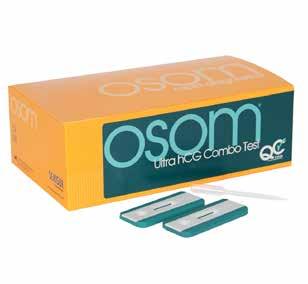
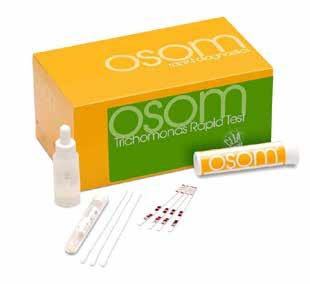
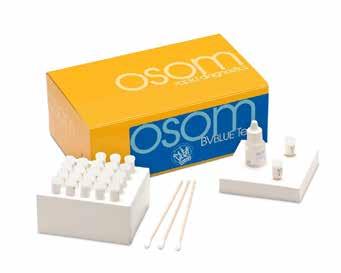
ULTRA HCG COMBO TEST
3026
3027
From Sekisui Diagnostics
The OSOM® Ultra hCG Combo test is a simple immunoassay for the qualitative detection of human chorionic gonadotropin (hCG) in serum or urine for the early confirmation of pregnancy. Internal studies have confirmed that the OSOM® Ultra hCG Combo test does not have a false negative result from hCG variants providing physicians with a higher level of confidence.
View Brochures, Videos & More at POR.io
Enter Number 3027 in the Search Area
20 | PHYSICIANS OFFICE RESOURCE PRODUCT FOCUS
WOMEN'S HEALTH
View Brochures, Videos & More at POR.io Enter Number 3026 in the Search Area


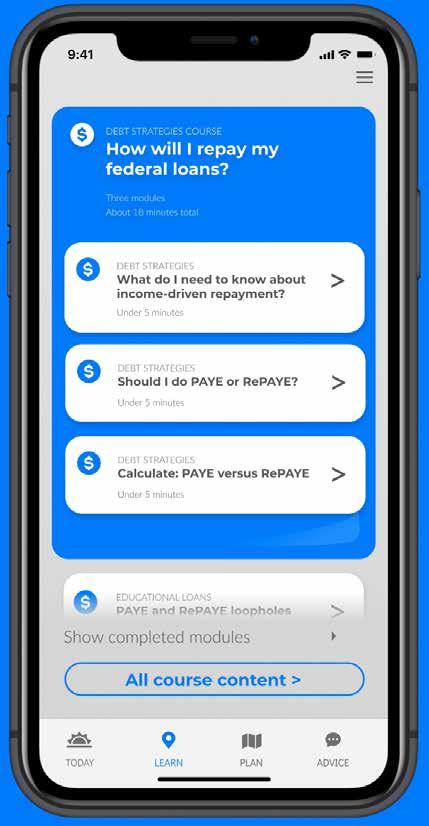
3028




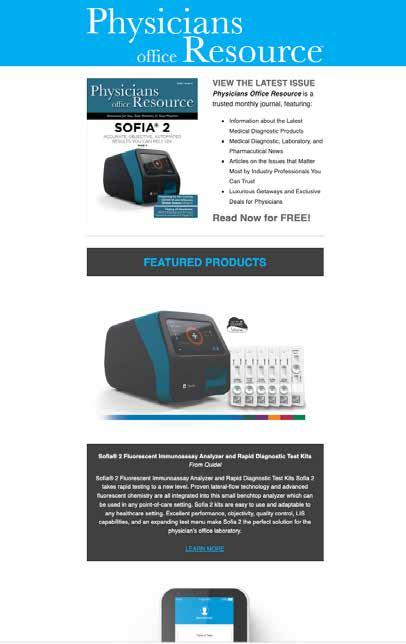


Sign up at PhysiciansOfficeResource.com/home/contact/ Physicians Office Resource Invites You to GO ELECTRONIC! Sign up for our monthly eNewsLetter and get Physicians Office Resource delivered to your Inbox! Physicians office Resource 2022 Issue 8 Resources for You, Your Patients, & Your Practice Point-of-care testing: A WINNING STRATEGY IN THE BATTLE AGAINST DIABETES PAGE 6 + TREATMENT? PAGE 36
THE STORY OF HIV PREVENTION with the first and only long-acting injectable PrEP option1








APRETUDE is administered as an intramuscular injection by a healthcare professional every 2 months after 2 initiation injections administered 1 month apart.



INDICATION
APRETUDE is indicated in at-risk adults and adolescents weighing at least 35 kg for pre-exposure prophylaxis (PrEP) to reduce the risk of sexually acquired HIV-1 infection. Individuals must have a negative HIV-1 test prior to initiating APRETUDE (with or without an oral lead-in with oral cabotegravir) for HIV-1 PrEP.
IMPORTANT SAFETY INFORMATION
BOXED WARNING: RISK OF DRUG RESISTANCE WITH USE OF APRETUDE FOR HIV-1 PRE-EXPOSURE PROPHYLAXIS (PrEP) IN UNDIAGNOSED



HIV-1 INFECTION
Individuals must be tested for HIV-1 infection prior to initiating APRETUDE or oral cabotegravir, and with each subsequent injection of APRETUDE, using a test approved or cleared by the FDA for the diagnosis of acute or primary HIV-1 infection. Drug-resistant HIV-1 variants have been identified with use of APRETUDE by individuals with undiagnosed HIV-1 infection. Do not initiate APRETUDE for HIV-1 PrEP unless negative infection status is confirmed. Individuals who become infected with HIV-1 while receiving APRETUDE for PrEP must transition to a complete HIV-1 treatment regimen.
Please see following pages for additional Important Safety Information. Please see following pages for Brief Summary of full Prescribing Information, including Boxed Warning, for APRETUDE.
PrEP=pre-exposure prophylaxis.
Only with APRETUDE:
SUPERIOR:
Provided
greater protection from HIV than a daily oral PrEP (TDF/FTC)
Significantly lower incidence of HIV-1 infection—69% (12* vs 39 [P =0.0003]) and 90% (3† vs 36 [P <0.0001])—vs a daily oral PrEP demonstrated in HPTN 083 and HPTN 0841-3‡§
• Of the incident and prevalent infections in the APRETUDE arm, INSTI resistanceassociated mutations (RAMs) were detected in 4 and 1 participant(s), respectively, in HPTN 083,1,4 and no major RAMs were detected in HPTN 0841
• Of the incident and prevalent infections in the TDF/FTC arm, NRTI RAMs were detected in 4 and 2 participants, respectively, in HPTN 083,4 and 1 incident infection with an NRTI RAM was detected in HPTN 0845
CONFIDENT:
Every-2-month dosing means no more daily PrEP pillsll
Adherence you can confirm with as few as 6 in-office injections per year1¶
• See additional dosing and HIV-1 testing information at APRETUDEHCP.com



*In HPTN 083, the primary analysis showed a 66% reduction in the risk of acquiring HIV-1 infection (hazard ratio [95% CI]: 0.34 [0.18-0.62]). Further testing revealed 1 of the infections on APRETUDE to be prevalent, yielding a 69% reduction in the risk of incident HIV-1 infection relative to TDF/FTC (hazard ratio [95% CI]: 0.31 [0.16-0.58]); incidence rate was 0.37/100 person-years for APRETUDE vs 1.22/100 person-years for TDF/FTC.1
†In HPTN 084, the primary analysis showed an 88% reduction in the risk of acquiring HIV-1 infection (hazard ratio [95% CI]: 0.12 [0.05-0.31]). Further testing revealed 1 of the infections on APRETUDE to be prevalent, yielding a 90% reduction in the risk of incident HIV-1 infection relative to TDF/FTC (hazard ratio [95% CI]: 0.10 [0.04-0.27]); incidence rate was 0.15/100 person-years for APRETUDE vs 1.85/100 person-years for TDF/FTC.1
‡HPTN 083 (N=4566) was a randomized, double-blind, placebo-controlled noninferiority trial of the safety and efficacy of APRETUDE compared with daily oral TDF/FTC for HIV-1 prevention in HIV-1–uninfected men and transgender women who have sex with men and have evidence of high-risk behavior for HIV-1 infection. The primary endpoint was the rate of incident HIV-1 infections among participants randomized to daily oral cabotegravir for up to 5 weeks followed by intramuscular injections of APRETUDE every 2 months compared with daily oral TDF/FTC (corrected for early stopping). The trial included the prespecified ability to test for superiority of APRETUDE over TDF/FTC.1,2









§HPTN 084 (N=3224) was a randomized, double-blind, placebo-controlled superiority trial of the safety and efficacy of APRETUDE compared with daily oral TDF/FTC for HIV-1 prevention in adult, uninfected cisgender women at risk of acquiring HIV-1. The primary endpoint was the rate of incident HIV-1 infections among participants randomized to daily oral cabotegravir for up to 5 weeks followed by injections of APRETUDE compared with oral TDF/FTC (corrected for early stopping).1,3
|| While on APRETUDE.
¶After initiation injections.1
IMPORTANT SAFETY INFORMATION (cont’d) CONTRAINDICATIONS
• Do not use APRETUDE in individuals:
° with unknown or positive HIV-1 status




° with previous hypersensitivity reaction to cabotegravir
° receiving carbamazepine, oxcarbazepine, phenobarbital, phenytoin, rifampin, and rifapentine
Please see following pages for additional Important Safety Information.
Please see following pages for Brief Summary of full Prescribing Information, including Boxed Warning, for APRETUDE.
Learn more about APRETUDE at APRETUDEHCP.com
your patients benefit from a switch to long-acting APRETUDE?
SUPERIOR efficacy proven in 2 trials and the CONFIDENCE that comes from adherence you can confirm in office1
Would
INCLUSIVE: Evaluated across a diverse population
The most diverse and comprehensive participant population in HIV prevention trials conducted to date1-3‡§

• Designed to include key populations at risk for HIV-1: Trials included HIV-1–negative cisgender men and transgender women who have sex with men and cisgender women, with the majority under age 301-3,6
• In the US, HPTN 083 was inclusive of the Black/African American and Latinx communities who comprise the greatest percentage of new HIV diagnoses1,2,7


SAFETY PROFILE1: Demonstrated in ~4000 participants








• The most common adverse reactions (all grades) observed in at least 1% of subjects receiving APRETUDE were ISRs, diarrhea, headache, pyrexia, fatigue, sleep disorders, nausea, dizziness, flatulence, abdominal pain, vomiting, myalgia, rash, decreased appetite, somnolence, back pain, and upper respiratory tract infection

- In HPTN 083, 82% of participants who received APRETUDE experienced at least 1 ISR; 97% were Grade 1 or 2, with 3% of participants experiencing Grade 3 and no Grade 4 reactions reported
- In HPTN 084, 38% of participants who received APRETUDE experienced at least 1 ISR;



>99% were Grade 1 or 2, with <1% of participants experiencing Grade 3 and no Grade 4 reactions reported
• 6% of participants receiving APRETUDE and 4% receiving TDF/FTC in HPTN 083, and 1% of participants in both arms of HPTN 084, discontinued due to adverse events (all causality)
CI=confidence interval; HPTN=HIV Prevention Trials Network; INSTI=integrase strand transfer inhibitor; ISR=injection-site reaction; NRTI=nucleoside/ nucleotide reverse transcriptase inhibitor; PrEP=pre-exposure prophylaxis; TDF/FTC=tenofovir disoproxil fumarate/emtricitabine.
IMPORTANT SAFETY INFORMATION (cont’d)
WARNINGS AND PRECAUTIONS
Comprehensive Management to Reduce the Risk of HIV-1 Infection:
• Use APRETUDE as part of a comprehensive prevention strategy, including adherence to the administration schedule and safer sex practices, including condoms, to reduce the risk of sexually transmitted infections (STIs). APRETUDE is not always effective in preventing HIV-1 acquisition. Risk for HIV-1 acquisition includes, but is not limited to, condomless sex, past or current STIs, self-identified HIV risk, having sexual partners of unknown HIV-1 viremic status, or sexual activity in a high prevalence area or network. Inform, counsel, and support individuals on the use of other prevention measures (e.g., consistent and correct condom use; knowledge of partner(s) HIV-1 status, including viral suppression status; regular testing for STIs)
• Use APRETUDE only in individuals confirmed to be HIV-1 negative. HIV-1 resistance substitutions may emerge in individuals with undiagnosed HIV-1 infection who are taking only APRETUDE, because APRETUDE alone does not constitute a complete regimen for HIV-1 treatment. Prior to initiating APRETUDE, ask seronegative individuals about recent (in past month) potential exposure events and evaluate for current or recent signs or symptoms consistent with acute HIV-1 infection (e.g., fever, fatigue, myalgia, skin rash). If recent (<1 month) exposures to HIV-1 are suspected or clinical symptoms consistent with acute HIV-1 infection are present, use a test approved or cleared by the FDA as an aid in the diagnosis of acute HIV-1 infection
2023 · ISSUE 7 | 25
IMPORTANT SAFETY INFORMATION (cont’d)
WARNINGS AND PRECAUTIONS (cont’d)
Comprehensive Management to Reduce the Risk of HIV-1 Infection: (cont’d)


• When using APRETUDE, HIV-1 testing should be repeated prior to each injection and upon diagnosis of any other STIs
• If an HIV-1 test indicates possible HIV-1 infection, or if symptoms consistent with acute HIV-1 infection develop following an exposure event, additional HIV testing to determine HIV status is needed. If HIV-1 infection is confirmed, then transition the individual to a complete HIV-1 treatment
• Counsel HIV-1 uninfected individuals to strictly adhere to the recommended dosing and testing schedule for APRETUDE
Potential Risk of Resistance with APRETUDE:
• There is a potential risk of developing resistance to APRETUDE if an individual acquires HIV-1 either before, while taking, or following discontinuation of APRETUDE. To minimize this risk, it is essential to clinically reassess individuals for risk of HIV-1 acquisition and to test before each injection to confirm HIV-1–negative status. Individuals who are confirmed to have HIV-1 infection must transition to a complete HIV-1 treatment. Alternative forms of PrEP should be considered following discontinuation of APRETUDE for those individuals at continuing risk of HIV-1 acquisition and initiated within 2 months of the final injection of APRETUDE
Long-Acting Properties and Potential Associated Risks with APRETUDE:
• Residual concentrations of cabotegravir may remain in the systemic circulation of individuals for prolonged periods (up to 12 months or longer). Take the prolonged-release characteristics of cabotegravir into consideration and carefully select individuals who agree to the required every-2-month injection dosing schedule because non-adherence to every-2-month injections or missed doses could lead to HIV-1 acquisition and development of resistance
Hypersensitivity Reactions:
• Serious or severe hypersensitivity reactions have been reported in association with other integrase inhibitors and could occur with APRETUDE
• Discontinue APRETUDE immediately if signs or symptoms of hypersensitivity reactions develop. Clinical status, including liver transaminases, should be monitored and appropriate therapy initiated
Hepatotoxicity:
• Hepatotoxicity has been reported in a limited number of individuals receiving cabotegravir with or without known pre-existing hepatic disease or identifiable risk factors
• Clinical and laboratory monitoring should be considered and APRETUDE should be discontinued if hepatotoxicity is suspected and individuals managed as clinically indicated
Trademarks are owned by or licensed to the ViiV Healthcare group of companies.
©2023 ViiV Healthcare or licensor.
CBTJRNA230005 May 2023
Produced in USA.
Learn more at APRETUDEHCP.com Talk to your patients about long-acting HIV prevention with APRETUDE
IMPORTANT SAFETY INFORMATION (cont’d)
WARNINGS AND PRECAUTIONS (cont’d)
Depressive Disorders:
• Depressive disorders (including depression, depressed mood, major depression, persistent depressive disorder, suicidal ideation or attempt) have been reported with APRETUDE
• Promptly evaluate patients with depressive symptoms
Risk of Reduced Drug Concentration of APRETUDE Due to Drug Interactions:
• The concomitant use of APRETUDE and other drugs may result in reduced drug concentration of APRETUDE
• Refer to the full Prescribing Information for steps to prevent or manage these possible and known significant drug interactions, including dosing recommendations. Consider the potential for drug interactions prior to and during use of, and after discontinuation of APRETUDE; review concomitant medications during use of APRETUDE
ADVERSE REACTIONS
The most common adverse reactions (incidence ≥1%, all grades) with APRETUDE were injection site reactions, diarrhea, headache, pyrexia, fatigue, sleep disorders, nausea, dizziness, flatulence, abdominal pain, vomiting, myalgia, rash, decreased appetite, somnolence, back pain, and upper respiratory tract infection.
DRUG INTERACTIONS
• Refer to the full Prescribing Information for important drug interactions with APRETUDE


• Drugs that induce UGT1A1 may significantly decrease the plasma concentrations of cabotegravir
USE IN SPECIFIC POPULATIONS
• Lactation: Assess the benefit-risk of using APRETUDE to the infant while breastfeeding due to the potential for adverse reactions and residual concentrations in the systemic circulation for up to 12 months or longer after discontinuation
• Pediatrics: Not recommended in individuals weighing less than 35 kg
Please see following pages for Brief Summary of full Prescribing Information, including Boxed Warning, for APRETUDE.
References: 1. APRETUDE [package insert]. Research Triangle Park, NC: ViiV Healthcare; 2021.
2. Landovitz RJ, Donnell D, Clement ME, et al; HPTN 083 Study Team. Cabotegravir for HIV prevention in cisgender men and transgender women. N Engl J Med. 2021;385:595-608. doi:10.1056/NEJMoa2101016 3. Delany-Moretlwe S; HPTN 084 Study Team. Long acting injectable cabotegravir is safe and effective in preventing HIV infection in cisgender women: results from HPTN 084. Presented at: HIV R4P Virtual Conference; January 27, 2021. Abstract LB1479. 4. Marzinke MA, Grinsztejn B, Fogel JM, et al. Characterization of human immunodeficiency virus (HIV) infection in cisgender men and transgender women who have sex with men receiving injectable cabotegravir for HIV prevention: HPTN 083. J Infect Dis. 2021;224(9):1581-1592. doi:10.1093/ infdis/jiab152 5. Marzinke MA, Delany-Moretlwe S, Agyei Y; HPTN 084 Study Team. Long-acting injectable PrEP in women: laboratory analysis of HIV infections in HPTN 084. Poster presented at: 11th International AIDS Society Conference on HIV Science; July 18-21, 2021. 6. HIV in the United States and dependent areas. Centers for Disease Control and Prevention. Updated August 9, 2021. Accessed March 11, 2022. https://www.cdc.gov/hiv/statistics/overview/ataglance.html
7. Centers for Disease Control and Prevention. HIV Surveillance Report, 2019. Vol 32. May 2021. https://www.cdc.gov/hiv/library/reports/hiv-surveillance/vol-32/index.html
APRETUDE(cabotegravir extended-release injectable suspension), for intramuscular use
The following is a brief summary only; see full Prescribing Information, including Boxed Warning, for complete product information.
WARNING: RISK OF DRUG RESISTANCE WITH USE OF APRETUDE FOR HIV-1 PRE-EXPOSURE PROPHYLAXIS (PrEP) IN UNDIAGNOSED HIV-1 INFECTION
Individuals must be tested for HIV-1 infection prior to initiating APRETUDE or oral cabotegravir, and with each subsequent injection of APRETUDE, using a test approved or cleared by the FDA for the diagnosis of acute or primary HIV-1 infection. Drug-resistant HIV-1 variants have been identified with use of APRETUDE by individuals with undiagnosed HIV-1 infection. Do not initiate APRETUDE for HIV-1 PrEP unless negative infection status is confirmed. Individuals who become infected with HIV-1 while receiving APRETUDE for PrEP must transition to a complete HIV-1 treatment regimen.
CONTRAINDICATIONS
APRETUDE is contraindicated in individuals: with unknown or positive HIV-1 status; with previous hypersensitivity reaction to cabotegravir; receiving the following coadministered drugs for which significant decreases in cabotegravir plasma concentrations may occur due to uridine diphosphate glucuronosyltransferase (UGT)1A1 enzyme induction, which may result in reduced effectiveness–Anticonvulsants: carbamazepine, oxcarbazepine, phenobarbital, phenytoin; Antimycobacterials: rifampin, rifapentine.
WARNINGS AND PRECAUTIONS
Comprehensive Management to Reduce the Risk of HIV-1 Infection: Use APRETUDE for HIV-1 PrEP to reduce the risk of HIV-1 infection as part of a comprehensive prevention strategy including adherence to the administration schedule and safer sex practices, including condoms, to reduce the risk of sexually transmitted infections (STIs). APRETUDE is not always effective in preventing HIV-1 acquisition. The time from initiation of APRETUDE for HIV-1 PrEP to maximal protection against HIV-1 infection is unknown. Risk for HIV-1 acquisition includes behavioral, biological, or epidemiologic factors including, but not limited to, condomless sex, past or current STIs, self-identified HIV risk, having sexual partners of unknown HIV-1 viremic status, or sexual activity in a high prevalence area or network. Counsel individuals on the use of other prevention measures (e.g., consistent and correct condom use; knowledge of partner(s)’ HIV-1 status, including viral suppression status; regular testing for STIs that can facilitate HIV-1 transmission). Inform individuals about and support their efforts in reducing sexual risk behavior. Use APRETUDE to reduce the risk of acquiring HIV-1 only in individuals confirmed to be HIV-1 negative. HIV-1 resistance substitutions may emerge in individuals with undiagnosed HIV-1 infection who are taking only APRETUDE, because APRETUDE alone does not constitute a complete regimen for HIV-1 treatment; therefore, care should be taken to minimize the risk of initiating or continuing APRETUDE before confirming the individual is HIV-1 negative. Prior to initiating APRETUDE for HIV-1 PrEP, ask seronegative individuals about recent (in past month) potential exposure events (e.g., condomless sex or condom breaking during sex with a partner of unknown HIV-1 status or unknown viremic status, a recent STI), and evaluate for current or recent signs or symptoms consistent with acute HIV-1 infection (e.g., fever, fatigue, myalgia, skin rash). If recent (<1 month) exposures to HIV-1 are suspected or clinical symptoms consistent with acute HIV-1 infection are present, use a test approved or cleared by the FDA as an aid in the diagnosis of acute or primary HIV-1 infection. When using APRETUDE for HIV-1 PrEP, HIV-1 testing should be repeated prior to each injection and upon diagnosis of any other STIs. If an HIV-1 test indicates possible HIV-1 infection, or if symptoms consistent with acute HIV-1 infection develop following an exposure event, additional HIV testing to determine HIV status is needed. If an individual has confirmed HIV-1 infection, then the individual must be transitioned to a complete HIV-1 treatment regimen. Counsel HIV-1–uninfected individuals to strictly adhere to the recommended dosing and testing schedule for APRETUDE in order to reduce the risk of HIV-1 acquisition and the potential development of resistance. Some individuals, such as adolescents, may benefit from frequent visits and counseling to support adherence to the dosing and testing schedule. Potential Risk of Resistance with APRETUDE: There is a potential risk of developing resistance to APRETUDE if an individual acquires HIV-1 either before or while taking APRETUDE or following discontinuation of
APRETUDE. To minimize this risk, it is essential to clinically reassess individuals for risk of HIV-1 acquisition and to test before each injection to confirm HIV-1 negative status. Individuals who are confirmed to have HIV-1 infection must transition to a complete HIV-1 treatment regimen. Alternative forms of PrEP should be considered following discontinuation of APRETUDE for those individuals at continuing risk of HIV-1 acquisition and initiated within 2 months of the final injection of APRETUDE. Long-Acting Properties and Potential Associated Risks with APRETUDE: Residual concentrations of cabotegravir may remain in the systemic circulation of individuals for prolonged periods (up to 12 months or longer). It is important to carefully select individuals who agree to the required every-2-month injection dosing schedule because non-adherence to every-2-monthly injections or missed doses could lead to HIV-1 acquisition and development of resistance. Healthcare providers should take the prolonged-release characteristics of cabotegravir into consideration when APRETUDE is prescribed. Hypersensitivity Reactions: Serious or severe hypersensitivity reactions have been reported in association with other integrase inhibitors and could occur with APRETUDE. Administration of cabotegravir oral lead-in dosing was used in clinical studies to help identify participants who may be at risk of a hypersensitivity reaction. Remain vigilant and discontinue APRETUDE if a hypersensitivity reaction is suspected. Discontinue APRETUDE immediately if signs or symptoms of hypersensitivity reactions develop (including, but not limited to, severe rash, or rash accompanied by fever, general malaise, fatigue, muscle or joint aches, blisters, mucosal involvement [oral blisters or lesions], conjunctivitis, facial edema, hepatitis, eosinophilia, angioedema, difficulty breathing). Clinical status, including liver transaminases, should be monitored and appropriate therapy initiated. For information regarding the long-acting properties of APRETUDE, see previous section. Hepatotoxicity: Hepatotoxicity has been reported in a limited number of individuals receiving cabotegravir with or without known pre-existing hepatic disease or identifiable risk factors. Clinical and laboratory monitoring should be considered and APRETUDE should be discontinued if hepatotoxicity is suspected and individuals managed as clinically indicated. For information regarding the long-acting properties of APRETUDE, see previous section. Depressive Disorders: Depressive disorders (including depression, depressed mood, major depression, persistent depressive disorder, suicide ideation or attempt) have been reported with APRETUDE. Promptly evaluate individuals with depressive symptoms to assess whether the symptoms are related to APRETUDE and to determine whether the risks of continued therapy outweigh the benefits. Risk of Reduced Drug Concentration of APRETUDE Due to Drug Interactions: The concomitant use of APRETUDE and other drugs may result in reduced drug concentration of APRETUDE. See DRUG INTERACTIONS section below for steps to prevent or manage these possible and known significant drug interactions, including dosing recommendations. Consider the potential for drug interactions prior to and during use of, and after discontinuation of APRETUDE; review concomitant medications during use of APRETUDE.
ADVERSE REACTIONS
Clinical Trials Experience: Because clinical trials are conducted under widely varying conditions, adverse reaction rates observed in the clinical trials of a drug cannot be directly compared with rates in the clinical trials of another drug and may not reflect rates observed in practice. Clinical Trials Experience in Adults: The safety assessment of APRETUDE is based on the analysis of data from 2 international, multicenter, double-blind trials, HPTN 083 and HPTN 084. Adverse reactions were reported while on blinded study product following exposure to APRETUDE extended-release injectable suspension and oral cabotegravir tablets as oral lead-in. The median time on blinded study product in HPTN 083 was 65 weeks and 2 days (range: 1 day to 156 weeks and 1 day), with a total exposure on cabotegravir of 3,231 person-years. The median time on blinded study product in HPTN 084 was 64 weeks and 1 day (range: 1 day to 153 weeks and 1 day), with a total exposure on cabotegravir of 2,009 person-years. The most common adverse reactions regardless of severity reported in at least 1% of participants in HPTN 083 or HPTN 084 are presented in Table 4. In HPTN 083, 6% of participants in the group receiving APRETUDE intramuscular injection every 2 months and 4% of participants receiving oral TRUVADA [emtricitabine (FTC) and tenofovir disoproxil fumarate (TDF)] once daily discontinued due to adverse events (all causality). Noninjection-site–associated adverse events leading to discontinuation and occurring in ≥1% of participants were increased alanine aminotransferase with APRETUDE and TRUVADA. In HPTN 084, 1% of participants receiving APRETUDE and 1% of participants receiving TRUVADA discontinued due to adverse events. The most commonly reported adverse event (all causality) leading to discontinuation was increased alanine aminotransferase (<1%) with APRETUDE and TRUVADA. The side-by-side tabulation is to simplify presentation; direct comparison across trials should not be made due to differing trials.
BRIEF SUMMARY
(cont’d on next page)
T:7" T:9.75"
BRIEF SUMMARY for APRETUDE (cabotegravir extended-release injectable suspension), for intramuscular use (cont'd)
APRETUDE Every 2 Months (n= 1,614)
TRUVADA Once Daily (n = 1,610)
Injection site reactionsb 82% 35%38%11%
Diarrhea4%5%4%4%
Headache4%3%12%13%
Pyrexiac 4%<1%<1%<1%
Fatigued 4%2%3%3%
Sleep disorderse 3%3%1%1%
Nausea3%5%4%8%
Dizziness2%3%4%6%
Flatulence1%1%<1%<1%
with the intramuscular administration of APRETUDE in HPTN 084 were ISRs. After 13,068 injections, 1,171 ISRs were reported. Of the 1,519 participants who received at least one injection of APRETUDE, 578 (38%) participants experienced at least one ISR. No participants discontinued APRETUDE because of ISRs. Among the participants who received APRETUDE and experienced at least one ISR, the maximum severity of reactions was mild (Grade 1) in 66% of participants, moderate (Grade 2) in 34% of participants, and severe (Grade 3) in less than 1% of participants. The median duration of overall ISR events was 8 days. The proportion of participants reporting ISRs at each visit and the severity of the ISRs generally decreased over time. The most commonly reported ISRs (all causality and grades) in at least 1% of participants who received APRETUDE and experienced at least one ISR from HPTN 084 are presented in Table 5.
Table 5. Injection Site Reactions (All Grades) Reported in at Least 1% of Participants who Experienced at Least One Injection Site Reaction (All Causality) with APRETUDE in Either HPTN 083 or HPTN 084
aAdverse reactions defined as “treatment-related” as assessed by the investigator, with exception of injection site reactions, where all injection site reactions were reported regardless of causality.
bParticipants who received injection: HPTN 083, APRETUDE (n = 2,117) and TRUVADA (n = 2,081); HPTN 084, APRETUDE (n = 1,519) and TRUVADA (n = 1,516).
cPyrexia includes pyrexia, feeling hot, chills, influenza-like illness.
dFatigue includes fatigue, malaise.
eSleep disorders includes insomnia, abnormal dreams.
fAbdominal pain includes abdominal pain, upper abdominal pain.
gRash includes rash, erythema, pruritus, macular, papular, maculopapular.
Injection-Associated Adverse Reactions: Local Injection Site Reactions (ISRs) with APRETUDE: The most frequent adverse reactions associated with the intramuscular administration of APRETUDE in HPTN 083 were ISRs. After 20,286 injections, 8,900 ISRs were reported. Of the 2,117 participants who received at least one injection of APRETUDE, 1,740 (82%) participants experienced at least one ISR, of which a total of 3% of participants discontinued APRETUDE because of ISRs. Among the participants who received APRETUDE and experienced at least one ISR, the maximum severity of reactions was mild (Grade 1) in 41% of participants, moderate (Grade 2) in 56% of participants, and severe (Grade 3) in 3% of participants. The median duration of overall ISR events was 4 days. The proportion of participants reporting ISRs at each visit and the severity of the ISRs decreased over time. The most commonly reported ISRs (all causality and grades) in at least 1% of participants who received APRETUDE and experienced at least one ISR from HPTN 083 are presented in Table 5. The most frequent adverse reactions associated
aPlacebo injectable suspension: intralipid 20% fat emulsion.
Other Injection-Associated Adverse Reactions: In the HPTN 083 clinical trial, an increased incidence of pyrexia (including pyrexia, feeling hot, chills, influenza-like illness) (4%) was reported by participants receiving APRETUDE compared with participants receiving TRUVADA (<1%). There were no differences reported in the incidence of pyrexia between groups in HPTN 084. Vasovagal or pre-syncopal reactions considered treatment related were reported in <1% of participants after injection with APRETUDE in HPTN 083. None were reported as treatment related by the investigators in HPTN 084.
Less Common Adverse Reactions: The following select adverse reactions (regardless of severity) occurred in <1% of participants receiving APRETUDE in HPTN 083 or HPTN 084: Hepatobiliary Disorders: Hepatotoxicity. Investigations: Weight increase (see below) Psychiatric Disorders: Depression.
Weight Increase: At the Week 41 and Week 97 timepoints in HPTN 083, participants who received APRETUDE gained a median of 1.2 kg (Interquartile Range [IQR]; -1.0, 3.5; n = 1,623) and 2.1 kg (IQR; -0.9, 5.9; n = 601) in weight from baseline. Those who received TRUVADA gained a median of 0 kg (IQR; -2.1, 2.4; n = 1,611) and 1 kg (IQR; -1.9, 4.0; n = 598) in weight from baseline, respectively. At the Week 41 and 97 timepoints in HPTN 084, participants who received APRETUDE gained a median of 2 kg (IQR; 0.0, 5.0; n = 1,151) and 4 kg (IQR; 0.0, 8.0; n = 216) in weight from baseline, respectively. Those who received TRUVADA gained a median of 1 kg (IQR; -1.0, 4.0; n = 1,131) and 3 kg (IQR; -1.0, 6.0; n = 218) in weight from baseline, respectively. Laboratory Abnormalities: Grade 3 or 4 post-baseline maximum toxicity laboratory abnormalities for HPTN 083 or HPTN 084 are summarized in Table 6.
(cont’d on next page)
Table 4. Adverse Drug Reactionsa (All Grades) Reported in at Least 1% of Participants Receiving APRETUDE in Either HPTN 083 or HPTN 084
Reactions
HPTN084 APRETUDE Every 2 Months (n =
TRUVADA Once Daily (n
Adverse
HPTN 083
2,281)
= 2,285)
Abdominal painf 1%1%2%2% Vomiting <1%1%2%5% Myalgia <1% <1%2%1% Rashg <1% <1%2%1% Decreased appetite <1% <1%2%4% Somnolence <1% <1%2%2% Back pain <1% <1%1%<1% Upper respiratory tract infection 0 <1%4%4%
Injection Site Reactions HPTN 083 HPTN 084 APRETUDE (n = 1,740) TRUVADAa (n= 724) APRETUDE (n= 578) TRUVADAa (n = 166) Pain/ tenderness 98%95%90% 87% Nodules15%2%14%2% Induration15%<1%12%2% Swelling12%1%18%3% Bruising4%4%1%0 Erythema 4%2%5% 2% Pruritus 3%3%6% 11% Warmth3%1%<1% 0 Anesthesia1%2%1% 2% Abscess <1%02% 3% Discoloration <1%01% 0 T:7" T:9.75"
BRIEF SUMMARY for APRETUDE (cabotegravir extended-release injectable suspension), for intramuscular use (cont'd)
from a population of uncertain size, it is not always possible to reliably estimate their frequency or establish a causal relationship to drug exposure.
Immune System Disorders
Hypersensitivity reactions (including angioedema and urticaria).
DRUG INTERACTIONS
Use of Other Antiretroviral Drugs after Discontinuation of APRETUDE: Residual concentrations of cabotegravir may remain in the systemic circulation of individuals for prolonged periods (up to 12 months or longer). These residual concentrations are not expected to affect the exposures of antiretroviral drugs that are initiated after discontinuation of APRETUDE. Potential for Other Drugs to Affect APRETUDE: Cabotegravir is primarily metabolized by UGT1A1 with some contribution from UGT1A9. Drugs that are strong inducers of UGT1A1 or 1A9 are expected to decrease cabotegravir plasma concentrations; therefore, coadministration of APRETUDE with these drugs is contraindicated. Established and Other Potentially Significant Drug Interactions: Information regarding potential drug interactions with cabotegravir is provided below. These recommendations are based on either drug interaction trials following oral administration of cabotegravir or predicted interactions due to the expected magnitude of the interaction. The information below includes potentially significant interactions but is not all inclusive.
• Anticonvulsants: carbamazepine, oxcarbazepine, phenobarbital, phenytoin – coadministration is contraindicated with APRETUDE due to potential for significant decreases in plasma concentration of APRETUDE
• Antimycobacterials: rifampin, rifapentine – coadministration is contraindicated with APRETUDE due to potential for significant decreases in plasma concentration of APRETUDE
ALT = Alanine transaminase, ULN = Upper limit of normal, AST = Aspartate aminotransferase.
Serum Lipids: Changes from baseline to Month 15 in total cholesterol, HDL cholesterol, LDL cholesterol, triglycerides, and total cholesterol to HDL ratio in HPTN 083 and HPTN 084 are presented in Table 7.
Table 7. Fasting Lipid Values, Median Change from Baselinea at Week 57, Reported in HPTN 083 and HPTN 084
• Antimycobacterial: rifabutin – when rifabutin is started before or concomitantly with the first initiation injection of APRETUDE, the recommended dosing of APRETUDE is one 600-mg (3-mL) injection, followed 2 weeks later by a second 600-mg (3-mL) initiation injection and monthly thereafter while on rifabutin. When rifabutin is started at the time of the second initiation injection or later, the recommended dosing schedule of APRETUDE is 600 mg (3 mL) monthly while on rifabutin. After stopping rifabutin, the recommended dosing schedule of APRETUDE is 600 mg (3 mL) every 2 months
Drugs without Clinically Significant Interactions with Cabotegravir: Based on drug interaction study results, the following drugs can be coadministered with cabotegravir (non-antiretrovirals) or given after discontinuation of cabotegravir (antiretrovirals and non-antiretrovirals) without a dose adjustment: etravirine, midazolam, oral contraceptives containing levonorgestrel and ethinyl estradiol, and rilpivirine. Consult the full Prescribing Information for potential drug interactions; this list is not all inclusive.
USE IN SPECIFIC POPULATIONS
aNearly 60% of participants with baseline data available had Week 57 data available in both arms of both trials. Within each trial, baseline values were comparable among participants receiving APRETUDE and TRUVADA.
Clinical Trials Experience in Adolescents: In adolescents receiving APRETUDE for HIV-1 PrEP, the safety data were comparable to the safety data reported in adults receiving APRETUDE for HIV-1 PrEP.
Postmarketing Experience
The following adverse reactions have been identified during postmarketing use of cabotegravir-containing regimens. Because these reactions are reported voluntarily
Pregnancy: Pregnancy Exposure Registry: There is a pregnancy exposure registry that monitors pregnancy outcomes in women exposed to APRETUDE during pregnancy. Healthcare providers are encouraged to register individuals by calling the Antiretroviral Pregnancy Registry (APR) at 1-800-258-4263. Risk Summary: There are insufficient human data on the use of APRETUDE during pregnancy to adequately assess a drug-associated risk of birth defects and miscarriage. While there are insufficient human data to assess the risk of neural tube defects (NTDs) with exposure to APRETUDE during pregnancy, NTDs were associated with dolutegravir, another integrase inhibitor. Discuss the benefit-risk of using APRETUDE with individuals of childbearing potential or during pregnancy. Cabotegravir use in pregnant women has not been evaluated. APRETUDE should be used during pregnancy only if the expected benefit justifies the potential risk to the fetus. The APR has been established to monitor for birth defects following prenatal exposure to antiretrovirals. The rate of miscarriage is not reported in the APR. The background rate for major birth defects in a U.S. reference population of the Metropolitan Atlanta Congenital Defects Program (MACDP) is 2.7%. The estimated background rate of miscarriage in clinically recognized pregnancies in the U.S. general population is 15% to 20%. The APR uses the MACDP as the U.S. reference population for birth defects in the general population. The MACDP evaluates women and infants from a limited geographic area and does not include outcomes for births that occurred at <20 weeks’ gestation. In animal reproduction studies with oral cabotegravir, a delay in the onset of parturition and increased stillbirths and neonatal deaths were observed in a rat pre- and postnatal development study at >28 times the exposure at the recommended human dose (RHD). No evidence of adverse developmental outcomes was observed with oral cabotegravir in
(cont’d on next page)
Table 6. Laboratory Abnormalities (Grades 3 to 4) in ≥1% of Participants in Either HPTN 083 or HPTN 084
Laboratory Parameter HPTN 083 HPTN
APRETUDE Every 2 Months (n = 2,281) TRUVADA Once Daily Once Daily (n = 2,285) APRETUDE Every 2 Months (n = 1,614) TRUVADA (n =1,610) ALT ( 5.0 x ULN) 2%2%<1%1% AST (5.0 x ULN) 3%3%<1%<1% Creatine phosphokinase ( 10.0 x ULN) 15%14%2%2% Lipase (3.0 x ULN) 3%3%<1%<1% Creatinine (>1.8 x ULN or increase to1.5 x baseline) 3%3%5%4%
084
HPTN 083 HPTN 084 APRETUDETRUVADA APRETUDETRUVADA Total cholesterol (mg/dL) +1.0-10.0+0.2 -3.9 LDL cholesterol (mg/dL) +1.0-6.0-1.1-5.0 HDL cholesterol (mg/dL) -0.2-3.0-0.8-2.6 Triglycerides (mg/dL) +2.7 0.0+3.1+0.7 Total cholesterol: HDL cholesterol ratio +0.1 +0.0+0.1+0.1 T:7" T:9.75"
BRIEF SUMMARY for APRETUDE (cabotegravir extended-release injectable suspension), for intramuscular use (cont'd)
rats or rabbits (>28 times or similar to the exposure at the RHD, respectively) given during organogenesis (see Data) Clinical Considerations: Cabotegravir is detected in systemic circulation for up to 12 months or longer after discontinuing injections of APRETUDE; therefore, consideration should be given to the potential for fetal exposure during pregnancy. Data: Human Data: Data from a birth outcome surveillance study in Botswana showed that dolutegravir, another integrase inhibitor, was associated with increased risk of NTDs when administered at the time of conception and in early pregnancy. Data from clinical trials are insufficient to address this risk with cabotegravir. Animal Data: Cabotegravir was administered orally to pregnant rats at 0, 0.5, 5, or 1,000 mg/kg/day from 15 days before cohabitation, during cohabitation, and from Gestation Days 0 to 17. There were no effects on fetal viability when fetuses were delivered by caesarean, although a minor decrease in fetal body weight was observed at 1,000 mg/kg/day (>28 times the exposure in humans at the RHD). No drug-related fetal toxicities were observed at 5 mg/kg/day (approximately 13 times the exposure in humans at the RHD), and no drug-related fetal malformations were observed at any dose. Cabotegravir was administered orally to pregnant rabbits at 0, 30, 500, or 2,000 mg/kg/day from Gestation Days 7 to 19. No drug-related fetal toxicities were observed at 2,000 mg/kg/day (approximately 0.7 times the exposure in humans at the RHD). In a rat pre- and postnatal development study, cabotegravir was administered orally to pregnant rats at 0, 0.5, 5, or 1,000 mg/kg/day from Gestation Day 6 to Lactation Day 21. A delay in the onset of parturition and increases in the number of stillbirths and neonatal deaths by Lactation Day 4 were observed at 1,000 mg/kg/day (>28 times the exposure in humans at the RHD); there were no alterations to growth and development of surviving offspring. In a cross-fostering study, similar incidences of stillbirths and early postnatal deaths were observed when rat pups born to cabotegravir-treated mothers were nursed from birth by control mothers. There was no effect on neonatal survival of control pups nursed from birth by cabotegravirtreated mothers. A lower dose of 5 mg/kg/day (13 times the exposure at the RHD) was not associated with delayed parturition or neonatal mortality in rats. Studies in pregnant rats showed that cabotegravir crosses the placenta and can be detected in fetal tissue. Lactation: Risk Summary: It is not known if cabotegravir is present in human breast milk, affects human milk production, or has effects on the breastfed infant. When administered to lactating rats, cabotegravir was present in milk (see Data). If cabotegravir is present in human milk, residual exposures may remain for 12 months or longer after the last injections have been administered. Because of detectable cabotegravir concentrations in systemic circulation for up to 12 months or longer after discontinuing injections of APRETUDE, it is recommended that women breastfeed only if the expected benefit justifies the potential risk to the infant. Data: Animal Data: Animal lactation studies with cabotegravir have not been conducted. However, cabotegravir was detected in the plasma of nursing pups on Lactation Day 10 in the rat pre- and postnatal development study. Pediatric Use: The safety and effectiveness of APRETUDE for HIV-1 PrEP in at-risk adolescents weighing at least 35 kg is supported by data from 2 adequate and well-controlled trials of APRETUDE for HIV-1 PrEP in adults with additional safety and pharmacokinetic data from studies in HIV-1–infected adults who were administered CABENUVA, and in HIV-1–infected pediatric subjects who were administered separate components of CABENUVA in addition to their current antiretroviral therapy. APRETUDE for HIV-1 PrEP is being evaluated in 2 open-label multicenter clinical trials in adolescent individuals. Fifty-nine adolescents have been enrolled. Of these, 54 adolescent participants received one or more injections. In adolescents receiving APRETUDE for HIV-1 PrEP, the safety data were comparable to the safety data reported in adults receiving APRETUDE for HIV-1 PrEP. While using APRETUDE, HIV-1 testing should be conducted prior to initiating APRETUDE (with or without an oral leadin with oral cabotegravir) and prior to each injection of APRETUDE. Adolescents may benefit from more frequent visits and counseling to support adherence to the dosing and testing schedule. The safety, efficacy, and pharmacokinetics of APRETUDE in pediatric participants younger than 12 years of age or weighing <35 kg have not been established. Geriatric Use: No dose adjustment is required in elderly individuals. There are limited data available on the use of APRETUDE in individuals aged 65 years and older. In general, caution should be exercised in administration of APRETUDE in elderly individuals, reflecting greater frequency of decreased hepatic, renal, or cardiac function and of concomitant disease or other drug therapy. Renal Impairment: Based on studies with oral cabotegravir, no dosage adjustment of APRETUDE is necessary for individuals with mild (creatinine clearance ≥60 to <90 mL/min) or moderate renal impairment (creatinine clearance ≥30 to <60 mL/min). In individuals with severe renal impairment (creatinine clearance 15 to <30 mL/min) or end-stage renal disease (creatinine clearance
<15 mL/min), increased monitoring for adverse effects is recommended. In individuals with end-stage renal disease not on dialysis, effects on the pharmacokinetics of cabotegravir are unknown. As cabotegravir is >99% protein bound, dialysis is not expected to alter exposures of cabotegravir. Hepatic Impairment: Based on studies with oral cabotegravir, no dosage adjustment of APRETUDE is necessary for individuals with mild or moderate hepatic impairment (Child-Pugh A or B). The effect of severe hepatic impairment (Child-Pugh C) on the pharmacokinetics of cabotegravir is unknown.
OVERDOSAGE
There is no known specific treatment for overdose with APRETUDE. If overdose occurs, monitor the individual and apply standard supportive treatment as required as well as observation of the clinical status of the individual. As APRETUDE is highly bound to plasma proteins, it is unlikely that it will be significantly removed by dialysis. Consider the prolonged exposure to APRETUDE following an injection when assessing treatment needs and recovery.
ViiV Healthcare Durham, NC 27701
APR:2BRS March 2023
GlaxoSmithKline Durham, NC 27701
APRETUDE and CABENUVA are trademarks owned by or licensed to the ViiV Healthcare group of companies.
The other brand listed is a trademark owned by or licensed to its respective owner and is not a trademark owned by or licensed to the ViiV Healthcare group of companies. The maker of this brand is not affiliated with and does not endorse the ViiV Healthcare group of companies or its products.
©2023 ViiV Healthcare or licensor.
CBTJRNA230005 April 2023 Produced in USA.
T:7" T:9.75"
Island
THE OCEAN CLUB , A FOUR SEASONS RESORT
BY JEN HELMLE
Paradise has been found! Literally and perhaps not so coincidentally on the northern shore of Paradise Island in the Bahamas. Welcome to The Ocean Club, A Four Seasons Resort. And it is epic. I have loved every location I have been lucky enough to travel to. Cities, the Southwest, ski resorts but the water is my love language. This being my first beach location I am still in pure bliss over this iconic destination.

Located about forty minutes from the Lynden Pindling National Airport (NAS) it is a short trip over the Paradise Island bridge from the bustling capital of Nassau with its rich Bahamian history, art galleries, duty-free shopping and casinos. Having just celebrated its diamond anniversary, the club originally opened in 1962. The location was a place back then for elite celebrities and wealthy internationals to escape to. In 2017, the Four Seasons made the Ocean Club part of its luxury destination portfolio. Since I love the uniqueness and next level dedication to each of their destinations, I can say this was an amazing addition to the Four Seasons name.
Once you cross over the bridge onto Paradise Island and enter the unassuming entrance to the FS Ocean Club you are immersed in the historic and tranquil filled grounds just waiting to blow you away with its diversity. When you pull up to the shell pink one
story lobby, which is its own building, you are greeted with the warmest Bahamian welcome. The lobby is beautiful and elegant with stunning artwork, floral arrangements, a gleaming piano and furnishings that remind you of the once elegant era the resort opened in. There are small sitting areas and a patio waiting for you to walk through to paradise. You will be offered a welcome beverage from the classy and classic Martini Bar and Lounge located in the building, with or without alcohol, to quench your thirst. I was lucky enough to come when the legend of the bar at FS Ocean Club, Keith Cash was there and he made my husband a personalized rum cocktail and I just had to go with champagne in a setting like this. One of the knowledgeable concierges at the desks will check you in and get you whisked into your accommodations so you can get down to the business of relaxing. Do not leave the lobby though without walking out the back through the french doors to get your first look at the turquoise water and white sand beach that will leave you speechless and excited to begin your adventure.
There are 107 guest accommodations at the FS Ocean Club. The low-profile buildings which are surrounded by tropical foliage and designed in the colonial design aesthetic are separated into two distinct “wings” of the resort. The more traditional Crescent Wing and the more modern chic Hartford Wing. The Hartford Wing
32 | PHYSICIANS OFFICE RESOURCE
Oasis

2023 · ISSUE 7 | 33
is right in the heart of the action at the resort. I stayed in the Crescent Wing, a very short walk from the lobby and Dune restaurant. The rooms are decorated with elegant and traditional island furnishings. Wood and cane beds, very large bathrooms which also include a soaking tub with marble and granite tiling. Large walk-in closet, a dry bar area, an inside sitting area with table and chairs and sleeper sofa. My ground level oceanfront room opened onto the most spectacular patio with table and chairs for al fresco dining and an upholstered lounger that can accommodate two people. I spent a lot of time there staring out

to the water. We were given the most thoughtful welcome gift of a FS Ocean club beach bag and two hats to provide some shade while we soaked in the sun. If you have a different need for your stay the resort also offers suites, private oceanfront villas with your own staff (yes please) and bungalows with plunge pools.
Once you are ready to get out of your private oasis you are going to go right into an oasis my words cannot relay to you. The grounds of the resort are spectacular! Tropical foliage and flowers, the greenest grass with hammocks and Adirondack chairs tucked away all over the property begging to be swayed or sat in. Palm trees strung with white lights to guide your path at night. There is a distinct area of the resort I found to be so fascinating for an ocean resort. As much as I just want to talk about the ocean (and I will) you cannot miss the Versailles Garden at the Ocean Club. It is magical! This flower filled, multi-tiered lawns and gardens are a jaw dropping area to explore on the 35-acre resort. This enclave is dotted with statues, stone, benches and structures that meticulously have been restored from a 12th century Augustinian Cloister. Walk your way up each tier of lushness filled with European history and Bahamian beauty and find yourself overlooking the Nassau Harbor at the top. I soaked it in taking that walk daily. I was fortunate enough to see a wedding tent set up in the Gardens and WOW is all I can say. If you want the European garden feel for a wedding or special event, you can achieve that at the Ocean Club just yards away from the water. Now that I mentioned water I can get to my pinnacle of peace. I love all water. Beaches reign supreme to me and nothing has compared so far to the beaches of the Ocean Club. Five miles of the most serene Atlantic Ocean white sand beach and turquoise water you can imagine. Peaceful, beautiful and just otherworldly. It is the star view from most of the rooms, restaurants and buildings. The entrance to the beach is just next to Dune restaurant and the Ocean infinity pool which feels like it is spilling into the Atlantic itself. Your feet aren’t hitting the sand without one of the lovely beach attendants escorting you to your shaded lounge chairs. There are complimentary waters, suntan lotions and cool cloths at your disposal. If you are craving a cocktail or beach eats, that can all be brought directly to your chair without even getting up. Two of the days I was there I was treated to live music from up at Dune Restaurant. It felt like having a private beach concert. If you do want to get up it is a beautiful walk up towards the golf course with rocks and waves to lap at your feet while you get some steps in. I think I took 200 pictures trying to capture how beautiful it was, but I don’t think a picture can hold a candle to seeing it in person.
Now if you get bored of just sitting and staring at perfection, then don’t worry about being bored. There is a LOT to do at the FS Ocean Club. There are water activities such as paddleboarding on the property, diving and snorkeling off site which can be arranged for you. Deep sea fishing and yacht charters are also available to be set up by one of the knowledgeable concierges at your convenience. Six

34 | PHYSICIANS OFFICE RESOURCE
Har-Tru tennis courts are waiting for you with lessons available if requested. For the golfers, the 18-hole Ocean Club golf course is waiting to be putted on while looking at views of the Atlantic and Nassau Harbor. For those that need to keep their fitness routine, a fully equipped gym with cardio and outdoor weight area are waiting to keep you on track. The gym is stocked with fresh fruit, water, headphones, and magazines. Personal training can be arranged and other fitness classes such as yoga are offered daily. If you prefer your cardio outside the resort has on-site jogging and walking trails and bikes available to ride if your feet get tired. There is a fully supervised FS Kids for All Seasons program and lovely staff waiting to educate and entertain the resort’s younger guests aged 4-12 daily in its own dedicated building. If you need retail therapy, you can hit the resorts boutique or arrange to head over to Nassau for some serious shopping. If a pool is your preferred water space or just need a change of scenery from the beach then you won’t be disappointed. The Ocean Club offers three unique pool experiences. The Ocean Pool located at the beachfront is an infinity pool for guests 16 and older with major people watching vibes and prime location. Food and beverages served poolside are always on the must list. I may have had a spicy margarita (or 4) while putting on my sunglasses and floppy hat and just basking in the scene. For those traveling with younger guests there is a family lagoon pool with an entry that slopes like a beach for easy water access. This pool also has a waterfall you can stand under and watch the kids splash away in their own
private place. If peace, quiet and tranquility is what you crave then the Versailles Pool is for you. An adult-only retreat located at the lush first tier of the gardens you can sip a cocktail, enjoy light food or lunch service either from your lounge chair or at the poolside Versailles Terrace restaurant. This pool is serene and elegant and gives such a unique experience away from the hustle of the beach. If anyone has major pool action on their list, the resort offers complimentary access to Aquaventure, the Atlantis Paradise resort’s massive water park located very close to the resort. Shuttle service is provided daily and is complimentary. I for one do not have that need every but my youngest son would be on that shuttle every day.
Ok back to things I like! SPA...... my favorite oasis where I can forget I am 50, a mother of 3, wife of 1, and TIRED like pretty much ninety-nine percent of humanity. I loved this spa experience. Very different from the other spas at FS resorts I have been to. Let me say every spa experience I have ever been fortunate enough to have at a FS resort has been next level. Each location uses indigenous ingredients to enhance their treatments and the commitment to the local environment shows. The design of this spa was so unique. The lobby is a standalone building featuring citrus waters, its own specially made hibiscus tea, light snacks and specially curated beauty products. The staff is warm and knowledgeable. After you check in your specialist comes to escort you out of the building into one of the 8 Balinese inspired private indoor/outdoor treatment villas. These villas have private outdoor gardens, bath and shower

2023 · ISSUE 7 | 35
area and wooden lounge beds and chairs to complete the total relaxation theme. It is like having your own little house to just block out the world for a few moments. Inside the villa is a fully modern, private treatment room with an indoor shower and bathroom. There are so many facial, body and signature treatments to choose from. I wish I could mention them all but please call the spa concierge to discuss your needs. I had chosen to try the coconut poultice massage and it was awesome. I have never felt my skin so soft, and it lasted until the next day. Do not miss getting an appointment in one of these little houses of bliss.
I like to save the best for last and if you have read anything I have written you know I excel at all things food and cocktail related. I love to cook at home and am infinitely curious about how to make food better. And nothing goes better with food than a cocktail. I’m average at the making part but great at the trying part. If you like to start your day with breakfast (who knows with intermittent fasting these days), then head to DUNE and enjoy an oceanfront meal with a latte or mimosa or fresh juice. The menu is fresh, caters to dietary needs and gets
you ready for whatever adventure is on your agenda. I enjoyed an omelet every morning with a delicious tomato salad. My husband mixed it up and had a frittata one morning and a chia bowl the next. If you are there on a Sunday, then brunch is a must do. Traditional brunch and Bahamian fare are fresh cooked and live music filling the room kills any Sunday blues away. If you aren’t having your lunch oceanside head to Ocean Blu located at the Ocean infinity pool and dine on tropical fare served with a Latin flare while you overlook the beach below. I suggest the spicy margarita to start or one of the delicious rum concoctions that scream you are in the Bahamas. I loved the tropical conch salad and shrimp tacos. I had it two days in a row! Delicious. If you are at the more secluded Versailles pool walk a few steps to the Versailles Terrace and enjoy food with Mediterranean influence and favorite pool bites. When the happiest hour of the day approaches a must do is get your more elegant attire out and head up to the Martini Bar and Lounge located in the lobby. This bar not only feels like you are immersed in a bygone era of glamorous living, but you are also in movie history. This bar was showcased the 2006 James Bond film Casino Royale. Having a perfectly shaken martini or a French 75 (my favorite) by the legendary and infinitely kind Keith Cash is honestly worth the trip.
If you are feeling like watching the sunset before dinner or an afternoon cocktail, then fun is always on the menu at the DUNE BAR. This oceanfront bar located next to DUNE is just plain cool. Great drinks being served up by amazing mixologists with quick smiles and tons of positive energy. The people watching isn’t too bad either. Try Sky Juice, Pink Sands or the Ocean Club Special like my husband or stick to champagne like me. Make sure to look for Ansel or Indsay to shake or pour you a glass of happiness. Every night I was there was live music and every single person that performed was awesome. It added the perfect touch to your afternoon or evening. The sunset is not to be missed while sitting on the outside deck. It is breathtaking and wonder filled that a sky could look so beautiful. When you head into DUNE I hope you are hungry for a menu by Michelin starred chef Jean-Georges Vongerichten’s imagination of French-Asian. A seafood platter to start the night always seems right to me. Add in some more conch salad, a spiny Caribbean lobster tail with greens and a New York strip steak and call it a night! Special thank you to our lovely server Samuel. A walk back to your room among the white lit palm trees or a sway in a hammock and looking at the starry sky listening to the ocean feet away is magic.
The national motto of the Bahamas is “Forward, Upward, Onward, Together.” I love this. The idea of being an individual but working with others to create and work toward a goal or nation or direction that one cannot do alone. We all need people and can learn from anyone that crosses our paths. You don’t have to be a travel writer to expand your horizons. It helps but your own backyard provides many opportunities to move upward and forward together. Keep learning from everyone you meet. Lend your knowledge to someone. You will move higher faster that way. Thank you, Dana Berry, the lovely hostess who led me to this magical island. I will treasure my time here and will be back ready for more.

36 | PHYSICIANS OFFICE RESOURCE

— PHYSICIANSOFFICERESOURCE.COM/MDESCAPES/ INSTAGRAM @MDESCAPES LUXURY TRAVEL DESTINATIONS | SPECIAL OFFERS | REVIEWS




38 | PHYSICIANS OFFICE RESOURCE
Our goal is to REWARD YOU
MDescapes features exclusive luxury travel discounts and offers! Our goal is to reward you, the healthcare professional, and help provide the rest, adventure, and memoires that accompany a luxury vacation.
FOUR SEASONS NEVIS
FOUR SEASONS PUNTA MITA
FOUR SEASONS NEW ORLEANS
FOUR SEASONS SANTA FE
CARTON HOUSE
SANDESTIN GOLF AND BEACH RESORT
AND MORE
— FIND
YOUR ESCAPE AT PhysiciansOfficeResource.com/MDescapes





We make diagnostics that matter We recognize your passion for providing accurate results which help diagnose and drive treatment decisions. We also know you are resilient and must navigate through some difficult and chaotic days while providing the best possible service to physicians, patients, and your organization. At SEKISUI Diagnostics, we are committed to providing high-quality, U.S.-made respiratory health rapid tests that are accurate and easy to use, allowing you to get the answers fast. Like you, we understand there is a patient behind every answer—and that’s what matters most. To learn more about our Flu Test promotions, visit osomtests.com or call 800-332-1042 Resilience + Passion © 2022 SEKISUI Diagnostics, LLC. All rights reserved. OSOM® is a registered trademark of SEKISUI Diagnostics, LLC. Because every result matters™ is a trademark of SEKISUI Diagnostics, LLC. OSOM® ULTRAPLUS FLU A&B TEST OSOM® MONO TEST OSOM® ULTRA STREP A TEST 3029 3030 3031





































































































